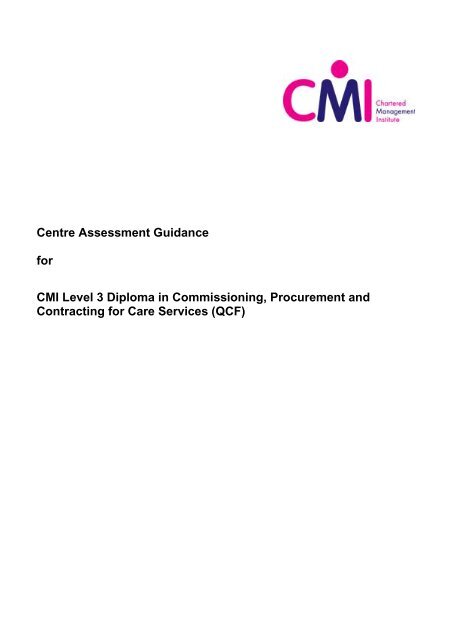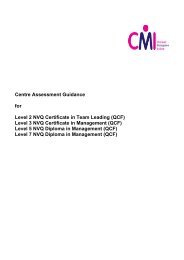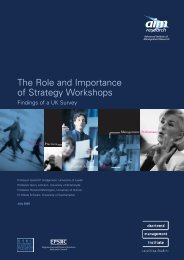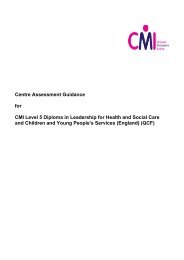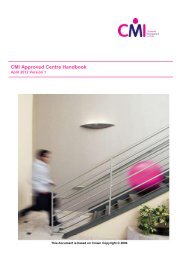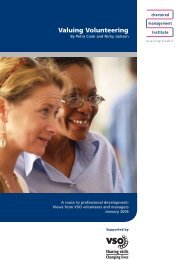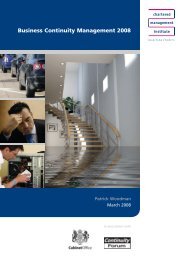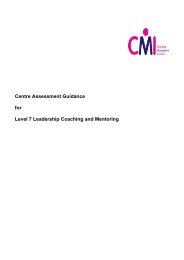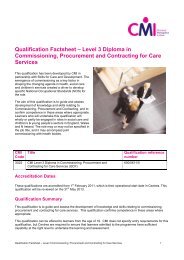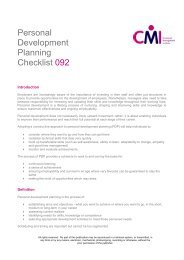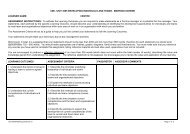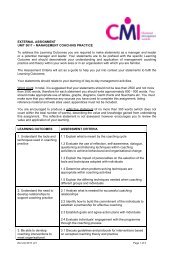Centre Assessment Guidance for CMI Level 3 Diploma in ...
Centre Assessment Guidance for CMI Level 3 Diploma in ...
Centre Assessment Guidance for CMI Level 3 Diploma in ...
Create successful ePaper yourself
Turn your PDF publications into a flip-book with our unique Google optimized e-Paper software.
<strong>Centre</strong> <strong>Assessment</strong> <strong>Guidance</strong><strong>for</strong><strong>CMI</strong> <strong>Level</strong> 3 <strong>Diploma</strong> <strong>in</strong> Commission<strong>in</strong>g, Procurement andContract<strong>in</strong>g <strong>for</strong> Care Services (QCF)
<strong>Level</strong> 3 <strong>Diploma</strong> <strong>in</strong> Commission<strong>in</strong>g, Procurement and Contract<strong>in</strong>g <strong>Centre</strong> <strong>Assessment</strong> <strong>Guidance</strong>ContentsPageIntroduction 4About these qualificationsTitles and qualifications reference numbers 4Accreditation dates 4Qualifications summary 4Progressions 4Credit values and rules of comb<strong>in</strong>ation <strong>for</strong> the qualifications 4Relationship to the National Occupational Standards 7<strong>Assessment</strong> and Verification 8What is expected of the learner? 10External <strong>Assessment</strong> 10Recognition of Prior Learn<strong>in</strong>g and achievement 11Support <strong>for</strong> <strong>Centre</strong>s 11Units 11SHC 31 Promote communication <strong>in</strong> health, social care or children’s and young people’sSett<strong>in</strong>gs 12SHC 32 Engage <strong>in</strong> personal development <strong>in</strong> health, social care or children’s and youngpeople’s sett<strong>in</strong>gs 14SHC 33 Promote equality and <strong>in</strong>clusion <strong>in</strong> health, social care or children’s and young people’sSett<strong>in</strong>gs 16SHC 34 Pr<strong>in</strong>ciples <strong>for</strong> implement<strong>in</strong>g duty of care <strong>in</strong> health, social care or children’sand young people’s sett<strong>in</strong>gs 17CPCCS 34 Address issues and conflicts <strong>in</strong> commission<strong>in</strong>g and contract<strong>in</strong>g <strong>for</strong> care services 18CPCCS 35 Work effectively with<strong>in</strong> a commission<strong>in</strong>g organisation 20CPCCS 36 Research and manage <strong>in</strong><strong>for</strong>mation <strong>in</strong> commission<strong>in</strong>g care services 22CPCCS 311 Promote effective communication to support decision-mak<strong>in</strong>g <strong>for</strong> the commission<strong>in</strong>gof services 24HSC 3046 Introduction to personalisation <strong>in</strong> social care 27CPCCS 315 Pr<strong>in</strong>ciples of safeguard<strong>in</strong>g children, young people and vulnerable adults 29ADVO 301 Purpose and pr<strong>in</strong>ciples of <strong>in</strong>dependent advocacy 31CMH 301 Understand mental well-be<strong>in</strong>g and mental health promotion 33CMH 302 Understand mental health problems 35CYP M3.1 Understand child and young person development 37CYP M3.7 Understand how to support positive outcomes <strong>for</strong> children and young people 40CYPOP 17 Understand the needs of children and young people who are vulnerable andexperienc<strong>in</strong>g poverty and disadvantage 42DEM 301 Understand the process and experience of dementia 44LD 201 Understand the context of support<strong>in</strong>g <strong>in</strong>dividuals with learn<strong>in</strong>g disabilities 46LD 310 Understand how to support <strong>in</strong>dividuals with autistic spectrum conditions 48Version 1 – Feb 11 Page 2 of 73
<strong>Level</strong> 3 <strong>Diploma</strong> <strong>in</strong> Commission<strong>in</strong>g, Procurement and Contract<strong>in</strong>g <strong>Centre</strong> <strong>Assessment</strong> <strong>Guidance</strong>PD OP 3.1 Understand physical disability 51PD OP 3.3 Understand the impact of Acquired Bra<strong>in</strong> Injury on <strong>in</strong>dividuals 53SS MU 3.1 Understand sensory loss 55SSOP 3.1 Understand models of disability 57CPCCS 38 Contribute to the plann<strong>in</strong>g and organisation of work <strong>in</strong> commission<strong>in</strong>g services 58CPCCS 313 Promote <strong>in</strong>novative ways of work<strong>in</strong>g when commission<strong>in</strong>g services 60CPCCS 515 Support decision mak<strong>in</strong>g and problem solv<strong>in</strong>g 62CPCCS 37 Contribute to establish<strong>in</strong>g and manag<strong>in</strong>g priorities and resources <strong>for</strong> services 64CPCCS 39 Plan and manage contracts to deliver care services 67CPCCS 310 Support the development of self-directed commission<strong>in</strong>g <strong>for</strong> care services 69CPCCS 312 Understand legislation and regulations <strong>for</strong> manag<strong>in</strong>g contracts to deliver care services 71CPCCS 314 Ensure contract compliance by contractors of care services 72Version 1 – Feb 11 Page 3 of 73
Introduction<strong>Level</strong> 3 <strong>Diploma</strong> <strong>in</strong> Commission<strong>in</strong>g, Procurement and Contract<strong>in</strong>g <strong>Centre</strong> <strong>Assessment</strong> <strong>Guidance</strong>This document aims to support Chartered Management Institute <strong>Centre</strong>s <strong>in</strong> the delivery, assessment andverification of the <strong>CMI</strong> <strong>Level</strong> 3 <strong>Diploma</strong> <strong>in</strong> Commission<strong>in</strong>g, Procurement and Contract<strong>in</strong>g <strong>for</strong> Care Services.About these qualificationsTitles and qualifications reference numbersThe titles given below are the titles as they will appear on the qualification when awarded to the learner. Thequalification reference number is the number allocated to the qualification by the Regulator at the time ofaccreditation, which confirms that this is a fundable qualification on the QCF. The <strong>CMI</strong> code is the code whichshould be used when register<strong>in</strong>g learners with <strong>CMI</strong>. Each unit also has a unique QCF unit number – this appearswith the content of each unit at the end of this document.<strong>CMI</strong>CodeTitleQualificationreference number3D22<strong>CMI</strong> <strong>Level</strong> 3 <strong>Diploma</strong> <strong>in</strong> Commission<strong>in</strong>g, Procurement and Contract<strong>in</strong>g <strong>for</strong>Care Services (QCF)600/0611/0Accreditation datesThese qualifications are accredited from 1 st February 2011, which is their operational start date <strong>in</strong> <strong>Centre</strong>s. Thisqualification will be reviewed on the 31 st May 2013.Qualifications summaryThis qualification is to guide and assess the development of knowledge and skills relat<strong>in</strong>g to commission<strong>in</strong>g,procurement and contract<strong>in</strong>g <strong>for</strong> care services. This qualification confirms competence <strong>in</strong> these areas whereappropriate.This qualification can be offered to learners from the age of 19. <strong>CMI</strong> does not specify entry requirements <strong>for</strong> thisqualification, but <strong>Centre</strong>s are required to ensure that learners admitted to the programme have sufficientcapability at the right level to undertake the learn<strong>in</strong>g and assessment.The qualification is offered <strong>in</strong> the medium of the English Language.ProgressionsIt is anticipated that learners will progress to the <strong>Level</strong> 5 QCF qualification relat<strong>in</strong>g to commission<strong>in</strong>g,procurement and contract<strong>in</strong>g <strong>for</strong> care services, or to other management roles or level 5 qualifications with<strong>in</strong>social care or related sectors.Credit values and rules of comb<strong>in</strong>ation <strong>for</strong> the qualificationsA credit value specifies the number of credits that will be awarded to a learner who has achieved the learn<strong>in</strong>goutcomes of the unit. The credit value of the unit will rema<strong>in</strong> constant <strong>in</strong> all contexts, regardless of theassessment method used or the qualification(s) to which it contributes. Learners will only be awarded credits <strong>for</strong>the successful completion of whole units. (One credit is awarded <strong>for</strong> those learn<strong>in</strong>g outcomes achievable <strong>in</strong> 10hours of learn<strong>in</strong>g time).Learn<strong>in</strong>g time is a notional measure of the amount of time a typical learner might be expected to take tocomplete all of the learn<strong>in</strong>g relevant to achievement of the learn<strong>in</strong>g outcomes <strong>in</strong> a given unit. Learn<strong>in</strong>g time<strong>in</strong>cludes activities such as directed study, assessment, tutorials, mentor<strong>in</strong>g and <strong>in</strong>dividual private study.Guided learn<strong>in</strong>g hours, however, are <strong>in</strong>tended to relate only to facilitated learn<strong>in</strong>g and associated assessments –<strong>in</strong>dividual private study is not <strong>in</strong>cluded – and are <strong>in</strong>tended to give guidance to delivery <strong>Centre</strong>s on the amount ofresource needed to deliver the programme and support learners. The units guided learn<strong>in</strong>g hours and rules ofcomb<strong>in</strong>ation <strong>for</strong> these qualifications are given <strong>in</strong> the tables 1 and 2.Version 1 – Feb 11 Page 4 of 73
<strong>Level</strong> 3 <strong>Diploma</strong> <strong>in</strong> Commission<strong>in</strong>g, Procurement and Contract<strong>in</strong>g <strong>Centre</strong> <strong>Assessment</strong> <strong>Guidance</strong>Table 1 – Units <strong>for</strong> <strong>CMI</strong> <strong>Level</strong> 3 <strong>Diploma</strong> <strong>in</strong> Commission<strong>in</strong>g, Procurement and Contract<strong>in</strong>g <strong>for</strong> CareServices (QCF)Units Credits GLHSHC 31 Promote communication <strong>in</strong> health, social care or children’s and 3 10young people’s sett<strong>in</strong>gsSHC 32 Engage <strong>in</strong> personal development <strong>in</strong> health, social care or children’s 3 10and young people’s sett<strong>in</strong>gsSHC 33 Promote equality and <strong>in</strong>clusion <strong>in</strong> health, social care or children’s 2 8and young people’s sett<strong>in</strong>gsSHC 34 Pr<strong>in</strong>ciples <strong>for</strong> implement<strong>in</strong>g duty of care <strong>in</strong> health, social care or 1 5children’s and young people’s sett<strong>in</strong>gsCPCCS 34 Address issues and conflicts <strong>in</strong> commission<strong>in</strong>g and contract<strong>in</strong>g <strong>for</strong> 3 25care servicesCPCCS 35 Work effectively with<strong>in</strong> a commission<strong>in</strong>g organisation 5 38CPCCS 36 Research and manage <strong>in</strong><strong>for</strong>mation <strong>in</strong> commission<strong>in</strong>g care services 3 23CPCCS 311 Promote effective communication to support decision-mak<strong>in</strong>g <strong>for</strong> the 3 23commission<strong>in</strong>g of servicesHSC 3046 Introduction to personalisation <strong>in</strong> social care 3 22CPCCS 315 Pr<strong>in</strong>ciples of safeguard<strong>in</strong>g children, young people and vulnerable 3 21adultsADVO 301 Purpose and pr<strong>in</strong>ciples of <strong>in</strong>dependent advocacy 4 25CMH 301 Understand mental well-be<strong>in</strong>g and mental health promotion 3 14CMH 302 Understand mental health problems 3 14CYP M3.1 Understand child and young person development 4 30CYP M3.7 Understand how to support positive outcomes <strong>for</strong> children and youngpeople3 25CYPOP 17 Understand the needs of children and young people who arevulnerable and experienc<strong>in</strong>g poverty and disadvantage 5 40DEM 301 Understand the process and experience of dementia 3 22LD 201 Understand the context of support<strong>in</strong>g <strong>in</strong>dividuals with learn<strong>in</strong>gdisabilities4 35LD 310 Understand how to support <strong>in</strong>dividuals with autistic spectrumconditions3 28PD OP 3.1 Understand physical disability 3 22PD OP 3.3 Understand the impact of Acquired Bra<strong>in</strong> Injury on <strong>in</strong>dividuals 3 28SS MU 3.1 Understand sensory loss 3 21SSOP 3.1 Understand models of disability 3 26CPCCS 38 Contribute to the plann<strong>in</strong>g and organisation of work <strong>in</strong> commission<strong>in</strong>g 4 28servicesCPCCS 313 Promote <strong>in</strong>novative ways of work<strong>in</strong>g when commission<strong>in</strong>g services 4 28CPCCS 515 Support decision mak<strong>in</strong>g and problem solv<strong>in</strong>g 5 35CPCCS 37 Contribute to establish<strong>in</strong>g and manag<strong>in</strong>g priorities and resources <strong>for</strong> 5 38servicesCPCCS 39 Plan and manage contracts to deliver care services 3 22CPCCS 310 Support the development of self-directed commission<strong>in</strong>g <strong>for</strong> care 5 38servicesCPCCS 312 Understand legislation and regulations <strong>for</strong> manag<strong>in</strong>g contracts to 3 25deliver care servicesCPCCS 314 Ensure contract compliance by contractors of care services 3 25Version 1 – Feb 11 Page 5 of 73
<strong>Level</strong> 3 <strong>Diploma</strong> <strong>in</strong> Commission<strong>in</strong>g, Procurement and Contract<strong>in</strong>g <strong>Centre</strong> <strong>Assessment</strong> <strong>Guidance</strong>Table 2 – Rules of comb<strong>in</strong>ation <strong>for</strong> <strong>CMI</strong> <strong>Level</strong> 3 <strong>Diploma</strong> <strong>in</strong> Commission<strong>in</strong>g, Procurement andContract<strong>in</strong>g <strong>for</strong> Care Services (QCF)<strong>Diploma</strong> - Learners need to complete all mandatory units <strong>in</strong> (Group A) to a total of 29 credits. One unit fromGroup B to a m<strong>in</strong>imum of 3 credits, one unit from Group C to a m<strong>in</strong>imum of 4 credits and a m<strong>in</strong>imum of 9 creditsfrom Group D. In group D, if a learner selects unit CPCCS39 or unit CPCCS14 then they must alsocomplete unit CPCCS312. Learners must achieve a m<strong>in</strong>imum of 45 credits to ga<strong>in</strong> the <strong>Level</strong> 3 <strong>Diploma</strong> <strong>in</strong>Commission<strong>in</strong>g, Procurement and Contract<strong>in</strong>g <strong>for</strong> Care Service.Units Credits GLHGroup ASHC 31 Promote communication <strong>in</strong> health, social care or children’s 3 10and young people’s sett<strong>in</strong>gsSHC 32 Engage <strong>in</strong> personal development <strong>in</strong> health, social care or 3 10children’s and young people’s sett<strong>in</strong>gsSHC 33 Promote equality and <strong>in</strong>clusion <strong>in</strong> health, social care or 2 8children’s and young people’s sett<strong>in</strong>gsSHC 34 Pr<strong>in</strong>ciples <strong>for</strong> implement<strong>in</strong>g duty of care <strong>in</strong> health, social care 1 5or children’s and young people’s sett<strong>in</strong>gsCPCCS 34 Address issues and conflicts <strong>in</strong> commission<strong>in</strong>g and3 25contract<strong>in</strong>g <strong>for</strong> care servicesCPCCS 35 Work effectively with<strong>in</strong> a commission<strong>in</strong>g organisation 5 38CPCCS 36 Research and manage <strong>in</strong><strong>for</strong>mation <strong>in</strong> commission<strong>in</strong>g care 3 23servicesCPCCS 311 Promote effective communication to support decisionmak<strong>in</strong>g3 23<strong>for</strong> the commission<strong>in</strong>g of servicesHSC 3046 Introduction to personalisation <strong>in</strong> social care 3 22CPCCS 315 Pr<strong>in</strong>ciples of safeguard<strong>in</strong>g children, young people and 3 21vulnerable adultsGroup BADVO 301 Purpose and pr<strong>in</strong>ciples of <strong>in</strong>dependent advocacy 4 25CMH 301 Understand mental well-be<strong>in</strong>g and mental health promotion 3 14CMH 302 Understand mental health problems 3 14CYP M3.1 Understand child and young person development 4 30CYP M3.7 Understand how to support positive outcomes <strong>for</strong> childrenand young people3 25CYPOP 17 Understand the needs of children and young people who arevulnerable and experienc<strong>in</strong>g poverty and disadvantage 5 40DEM 301 Understand the process and experience of dementia 3 22LD 201 Understand the context of support<strong>in</strong>g <strong>in</strong>dividuals withlearn<strong>in</strong>g disabilities4 35LD 310 Understand how to support <strong>in</strong>dividuals with autistic spectrumconditions3 28PD OP 3.1 Understand physical disability 3 22PD OP 3.3 Understand the impact of Acquired Bra<strong>in</strong> Injury on<strong>in</strong>dividuals3 28SS MU 3.1 Understand sensory loss 3 21SSOP 3.1 Understand models of disability 3 26Group CCPCCS 38 Contribute to the plann<strong>in</strong>g and organisation of work <strong>in</strong> 4 28commission<strong>in</strong>g servicesCPCCS 313 Promote <strong>in</strong>novative ways of work<strong>in</strong>g when commission<strong>in</strong>gservices4 28Version 1 – Feb 11 Page 6 of 73
<strong>Level</strong> 3 <strong>Diploma</strong> <strong>in</strong> Commission<strong>in</strong>g, Procurement and Contract<strong>in</strong>g <strong>Centre</strong> <strong>Assessment</strong> <strong>Guidance</strong>CPCCS 515 Support decision mak<strong>in</strong>g and problem solv<strong>in</strong>g 5 35Group DCPCCS 37 Contribute to establish<strong>in</strong>g and manag<strong>in</strong>g priorities and 5 38resources <strong>for</strong> servicesCPCCS 39 Plan and manage contracts to deliver care services 3 22CPCCS 310 Support the development of self-directed commission<strong>in</strong>g <strong>for</strong> 5 38care servicesCPCCS 312 Understand legislation and regulations <strong>for</strong> manag<strong>in</strong>g 3 25contracts to deliver care servicesCPCCS 314 Ensure contract compliance by contractors of care services 3 25Relationship to National Occupational Standards <strong>for</strong> Management and LeadershipThe relationship of each unit to the Management and Leadership NOS is shown <strong>in</strong> table 3:Table 3 – Relationship to NOSUnitsNOS UnitsSHC 31 Promote communication <strong>in</strong> health, social care orchildren’s and young people’s sett<strong>in</strong>gsCCLD 301GCU 1GEN 22HSC 31 Themes recur as knowledgerequirements and core valuesthroughout HSC NOSSHC 32 Engage <strong>in</strong> personal development <strong>in</strong> health, socialcare or children’s and young people’s sett<strong>in</strong>gsCCLD 304GCU 6GEN 12GEN 13HSC 33 Themes recur as knowledgerequirements, per<strong>for</strong>mance criteria andcore values throughout HSC NOSSHC 33 Promote equality and <strong>in</strong>clusion <strong>in</strong> health, social careor children’s and young people’s sett<strong>in</strong>gsCCLD 305GCU 5HSC 34 HSC 35 HSC 3116 Themesrecur as knowledge requirements andcore values throughout HSC and CCLDNOSSHC 34 Pr<strong>in</strong>ciples <strong>for</strong> implement<strong>in</strong>g duty of care <strong>in</strong> health,social care or children’s and young people’s sett<strong>in</strong>gsCCLD 305GCU 2HSC 24 HSC 34 HSC 35 Themesrecur as knowledge requirements andcore values throughout HSC and CCLDNOSCPCCS 34 Address issues and conflicts <strong>in</strong> commission<strong>in</strong>g and CPC 304contract<strong>in</strong>g <strong>for</strong> care servicesCPCCS 35 Work effectively with<strong>in</strong> a commission<strong>in</strong>g organisation CPC NOS 301 and 302CPCCS 36 Research and manage <strong>in</strong><strong>for</strong>mation <strong>in</strong> commission<strong>in</strong>g CPC NOS 303care servicesCPCCS Promote effective communication to support CPC NOS L3 Units 311 and 313311 decision-mak<strong>in</strong>g <strong>for</strong> the commission<strong>in</strong>g of servicesHSC 3046 Introduction to personalisation <strong>in</strong> social care HSC 24 HSC 35 HSC 346 HSC3119CPCCS315Pr<strong>in</strong>ciples of safeguard<strong>in</strong>g children, young peopleand vulnerable adultsContent recurs throughout CCLD, CPC,HSC and LDSS NOS (knowledgerequirements)Specifically <strong>in</strong> HSC 34, HSC 35,HSC335, CCLD 305, LDSS 1ADVO 301 Purpose and pr<strong>in</strong>ciples of <strong>in</strong>dependent advocacyCMH 301 Understand mental well-be<strong>in</strong>g and mental healthpromotionVersion 1 – Feb 11 Page 7 of 73
<strong>Level</strong> 3 <strong>Diploma</strong> <strong>in</strong> Commission<strong>in</strong>g, Procurement and Contract<strong>in</strong>g <strong>Centre</strong> <strong>Assessment</strong> <strong>Guidance</strong>CMH 302 Understand mental health problemsCYP M3.1 Understand child and young person development CCLD NOS Unit 303: Promotechildren’s development HSC36Contribute to the assessment of childrenand young peoples' needs and thedevelopment of care plans CWDCTra<strong>in</strong><strong>in</strong>g, Support and Developmentstandards <strong>for</strong> Foster Care, Standard 5:Understand the development of childrenand young peopleCYP M3.7 Understand how to support positive outcomes <strong>for</strong>children and young peopleCYPOP 17 Understand the needs of children and young peoplewho are vulnerable and experienc<strong>in</strong>g poverty anddisadvantageDEM 301 Understand the process and experience of dementiaLD 201 Understand the context of support<strong>in</strong>g <strong>in</strong>dividuals withlearn<strong>in</strong>g disabilitiesLD 310 Understand how to support <strong>in</strong>dividuals with autisticspectrum conditionsPD OP 3.1 Understand physical disabilityPD OP 3.3 Understand the impact of Acquired Bra<strong>in</strong> Injury on<strong>in</strong>dividualsSS MU 3.1 Understand sensory lossSSOP 3.1 Understand models of disabilityCPCCS 38 Contribute to the plann<strong>in</strong>g and organisation of work<strong>in</strong> commission<strong>in</strong>g servicesCPCCS Promote <strong>in</strong>novative ways of work<strong>in</strong>g when313 commission<strong>in</strong>g servicesCPCCS Support decision mak<strong>in</strong>g and problem solv<strong>in</strong>g515CPCCS 37 Contribute to establish<strong>in</strong>g and manag<strong>in</strong>g prioritiesand resources <strong>for</strong> servicesCPCCS 39 Plan and manage contracts to deliver care servicesCPCCS Support the development of self-directed310 commission<strong>in</strong>g <strong>for</strong> care servicesCPCCS Understand legislation and regulations <strong>for</strong> manag<strong>in</strong>g312CPCCS314contracts to deliver care servicesEnsure contract compliance by contractors of careservices<strong>Assessment</strong> and verificationThe ma<strong>in</strong> objective of the assessment of this qualification will be to meet the assessment criteria detailed with<strong>in</strong>each unit.The primary <strong>in</strong>terface with the learner is the Assessor whose job it is to assess the evidence presented by thelearner. The Assessor should provide an audit trail show<strong>in</strong>g how the judgement of the learner’s overallachievement has been arrived at.The <strong>Centre</strong>’s assessment plan, to be agreed with the external verifier, should <strong>in</strong>clude a matrix <strong>for</strong> thequalification show<strong>in</strong>g how each unit is to be assessed aga<strong>in</strong>st the relevant criteria and which specific piece orpieces of work will be identified <strong>in</strong> relation to each unit. It should also show how assessment is scheduled <strong>in</strong>tothe delivery programme.In design<strong>in</strong>g the <strong>in</strong>dividual tasks and activities, centres must ensure that:• the selected assessment task/activity is relevant to the content of the unitVersion 1 – Feb 11 Page 8 of 73
<strong>Level</strong> 3 <strong>Diploma</strong> <strong>in</strong> Commission<strong>in</strong>g, Procurement and Contract<strong>in</strong>g <strong>Centre</strong> <strong>Assessment</strong> <strong>Guidance</strong>• there are clear <strong>in</strong>structions given to learners as to what is expected• learners are clearly told how long the assessment will take (if it is a timed activity), and what reference orother material they may use (if any) to complete it• the language used <strong>in</strong> the assessment is free from any bias• the language and technical terms used are at the appropriate level <strong>for</strong> the learnersIn addition to the specific assessment criteria <strong>in</strong> each unit, the learner’s work must be:• accurate, current and authentic• relevant <strong>in</strong> depth and breadthand must also show the learner’s:• clear grasp of concepts• ability to l<strong>in</strong>k theory to practice, and• ability to communicate clearly <strong>in</strong> the relevant discipl<strong>in</strong>e at the expected level <strong>for</strong> the qualificationLearners’ work <strong>for</strong> <strong>CMI</strong> purposes is given a “pass” result. There is no grad<strong>in</strong>g <strong>for</strong> <strong>CMI</strong> qualifications, and externalverification of learners’ work only confirms that the required criteria <strong>for</strong> achievement have been met. <strong>Centre</strong>s are,of course, free to apply their own grade scales, but it must be understood that these are completely separatefrom the <strong>CMI</strong> qualification.<strong>Assessment</strong> through Per<strong>for</strong>mance <strong>in</strong> the Workplace<strong>Assessment</strong> decisions <strong>for</strong> competence based learn<strong>in</strong>g outcomes (e.g. those beg<strong>in</strong>n<strong>in</strong>g with’ to be able to’) mustbe made <strong>in</strong> a real work environment by an occupationally competent assessor. Any knowledge evidence <strong>in</strong>tegralto these learn<strong>in</strong>g outcomes may be generated outside of the work environment but the f<strong>in</strong>al assessment decisionmust be with<strong>in</strong> the real work environment.<strong>Assessment</strong> decisions <strong>for</strong> competence based Learn<strong>in</strong>g Outcomes must be made by an assessor qualified tomake assessment decisions.Competence based assessment must <strong>in</strong>clude direct observation as the ma<strong>in</strong> source of evidenceExpert witnesses can be used <strong>for</strong> direct observation where: they have occupational expertise <strong>for</strong> specialistareas or the observation is of a particularly sensitive nature. The use of expert witnesses should be determ<strong>in</strong>edand agreed by the assessor.<strong>Assessment</strong> of knowledge based Learn<strong>in</strong>g Outcomes (e.g. those beg<strong>in</strong>n<strong>in</strong>g with ‘know’ or ‘understand’) maytake place <strong>in</strong> or outside of a real work environment.<strong>Assessment</strong> decisions <strong>for</strong> knowledge based Learn<strong>in</strong>g Outcomes must be made by an occupationallyknowledgeable assessor.<strong>Assessment</strong> decisions <strong>for</strong> knowledge based Learn<strong>in</strong>g Outcomes must be made by an assessor qualified to makeassessment decisions. Where assessment is electronic or undertaken accord<strong>in</strong>g to a set grid, the assessmentdecisions are made by the person who has set the answers.Internal Quality AssuranceInternal quality assurance is key <strong>for</strong> ensur<strong>in</strong>g that the assessment of evidence <strong>for</strong> units is of a consistent andappropriate quality. Those carry<strong>in</strong>g out <strong>in</strong>ternal quality assurance must be occupationally knowledgeable <strong>in</strong> thearea they are assur<strong>in</strong>g and be qualified to make quality assurance decisions.Def<strong>in</strong>itionsOccupationally competent:This means that each assessor must be capable of carry<strong>in</strong>g out the full requirements with<strong>in</strong> the competencyunits they are assess<strong>in</strong>g. Be<strong>in</strong>g occupationally competent means they are also occupationally knowledgeable.This occupational competence should be ma<strong>in</strong>ta<strong>in</strong>ed annually through clearly demonstrable cont<strong>in</strong>u<strong>in</strong>g learn<strong>in</strong>gand professional development.Version 1 – Feb 11 Page 9 of 73
<strong>Level</strong> 3 <strong>Diploma</strong> <strong>in</strong> Commission<strong>in</strong>g, Procurement and Contract<strong>in</strong>g <strong>Centre</strong> <strong>Assessment</strong> <strong>Guidance</strong>Occupationally knowledgeable:This means that each assessor should possess relevant knowledge and understand<strong>in</strong>g, and be able to assessthis <strong>in</strong> units designed to test specific knowledge and understand<strong>in</strong>g, or <strong>in</strong> units where knowledge andunderstand<strong>in</strong>g are components of competency. This occupational knowledge should be ma<strong>in</strong>ta<strong>in</strong>ed annuallythrough clearly demonstrable cont<strong>in</strong>u<strong>in</strong>g learn<strong>in</strong>g and professional development.Qualified to make assessment decisions:This means that each assessor must hold a qualification suitable to support the mak<strong>in</strong>g of appropriate andconsistent assessment decisions. Award<strong>in</strong>g Organisations will determ<strong>in</strong>e what will qualify those mak<strong>in</strong>gassessment decisions accord<strong>in</strong>g to the unit of competence under assessment. In any case of significantuncerta<strong>in</strong>ty the SSCs will be consulted.Qualified to make quality assurance decisions:Award<strong>in</strong>g Organisations will determ<strong>in</strong>e what will qualify those undertak<strong>in</strong>g <strong>in</strong>ternal quality assurances to makedecisions about that quality assurance.Expert witness:An expert witness must:• have a work<strong>in</strong>g knowledge of the QCF units on which their expertise is based• be occupationally competent <strong>in</strong> their area of expertise.• have EITHER any qualification <strong>in</strong> assessment of workplace per<strong>for</strong>mance OR a professional work rolewhich <strong>in</strong>volves evaluat<strong>in</strong>g the everyday practice of staff.<strong>Assessment</strong> by SimulationSimulation may only be utilised as an assessment method <strong>for</strong> competence based Lo where this is specified <strong>in</strong>the assessment requirements of the unit’.What work is expected of the learner?It is important to ensure consistency of assessment, and that demands made on learners are comparable with<strong>in</strong>and between centres. A number of assessment methods can be used. <strong>Centre</strong>s are encouraged to use a range ofmethods to ensure that all the learn<strong>in</strong>g outcomes and assessment criteria are met, and to enhance learners’development.<strong>Assessment</strong> through:-• observable per<strong>for</strong>mance• physical products of work• reports• plans• correspondence• witness testimony• discussion• question<strong>in</strong>gIn some <strong>in</strong>stances, as well as written work, use can be made of technology. It is important, however, to ensuresufficient traceability <strong>for</strong> assessment and verification.The written word, however generated and recorded, is still expected to <strong>for</strong>m the majority of assessable workproduced by learners at <strong>Level</strong> 3. The amount and volume of work <strong>for</strong> each unit at this level should be broadlycomparable to a word count of words.<strong>Centre</strong>s and learners are encouraged to use methods of present<strong>in</strong>g data, analysis and <strong>in</strong><strong>for</strong>mation other thanstraight<strong>for</strong>ward narrative text. In the appropriate contexts, tables, graphs, pie charts, diagrams and illustrationsare just as demand<strong>in</strong>g on the learner.Version 1 – Feb 11 Page 10 of 73
<strong>Level</strong> 3 <strong>Diploma</strong> <strong>in</strong> Commission<strong>in</strong>g, Procurement and Contract<strong>in</strong>g <strong>Centre</strong> <strong>Assessment</strong> <strong>Guidance</strong>Recognition of Prior Learn<strong>in</strong>g and AchievementThe Qualifications and Credit framework is based on the pr<strong>in</strong>ciple of credit accumulation and transfer. With<strong>in</strong>this suite of qualifications, learners have the opportunity to build their achievements from a s<strong>in</strong>gle unit <strong>in</strong>to a full<strong>Diploma</strong>. <strong>CMI</strong> will publish on its website which units and qualifications from other Award<strong>in</strong>g Bodies can berecognised <strong>for</strong> credit transfer and exemption. Credit transfer <strong>in</strong> the QCF will be based on confirmation ofachievement of QCF numbered units.There will of course still be <strong>in</strong>stances where learners will wish to claim recognition of prior learn<strong>in</strong>g which hasnot been <strong>for</strong>mally assessed and accredited. In those <strong>in</strong>stances, <strong>Centre</strong>s are free, after discussion andagreement with their External Verifier, to allow these learners direct access to the relevant assessment <strong>for</strong> theunit, without unnecessary repetition of learn<strong>in</strong>g. Details of the process <strong>for</strong> record<strong>in</strong>g such RPL (Recognition ofPrior Learn<strong>in</strong>g) are <strong>in</strong>cluded <strong>in</strong> the <strong>CMI</strong> <strong>Centre</strong> Code of Practice.Support <strong>for</strong> <strong>Centre</strong>sStaff at Approved <strong>Centre</strong>s are offered group membership of <strong>CMI</strong>, enabl<strong>in</strong>g them to access all the support and<strong>in</strong><strong>for</strong>mation available to their learners. More <strong>in</strong><strong>for</strong>mation about what is available is detailed <strong>in</strong> the <strong>CMI</strong> <strong>Centre</strong>Code of Practice, and via the website www.managers.org.uk/qualificationsUnitsThe content of the units <strong>for</strong> the <strong>Level</strong> 3 suite of qualifications follow.Access<strong>in</strong>g the units via the <strong>CMI</strong> website will enable <strong>Centre</strong>s also to access support and read<strong>in</strong>g material fromthe Study Resource <strong>Centre</strong>.Version 1 – Feb 11 Page 11 of 73
<strong>Level</strong> 3 <strong>Diploma</strong> <strong>in</strong> Commission<strong>in</strong>g, Procurement and Contract<strong>in</strong>g <strong>Centre</strong> <strong>Assessment</strong> <strong>Guidance</strong>Title:Promote communication <strong>in</strong> health, social care or children’s and youngpeople’s sett<strong>in</strong>gs<strong>Level</strong>: 3 Unit Number: SHC31 QCA UnitNumber:J/601/1434Credit value: 3 Guided Learn<strong>in</strong>gHours10Learn<strong>in</strong>g outcomes<strong>Assessment</strong> criteriaThe learner will:1. Understand why effectivecommunication is important <strong>in</strong> the worksett<strong>in</strong>g2. Be able to meet the communication andlanguage needs, wishes and preferencesof <strong>in</strong>dividualsThe learner can:1.1 Identify the different reasons peoplecommunicate1.2 Expla<strong>in</strong> how communication affectsrelationships <strong>in</strong> the work sett<strong>in</strong>g2.1 Demonstrate how to establish thecommunication and language needs, wishesand preferences of <strong>in</strong>dividuals2.2 Describe the factors to consider whenpromot<strong>in</strong>g effective communication2.3 Demonstrate a range of communicationmethods and styles to meet <strong>in</strong>dividual needs2.4 Demonstrate how to respond to an<strong>in</strong>dividual’s reactions when communicat<strong>in</strong>g3. Be able to overcome barriers tocommunication3.1 Expla<strong>in</strong> how people from differentbackgrounds may use and/or <strong>in</strong>terpretcommunication methods <strong>in</strong> different ways3.2 Identify barriers to effective communication3.3 Demonstrate ways to overcome barriers tocommunication3.4 Demonstrate strategies that can be used toclarify misunderstand<strong>in</strong>gs3.5 Expla<strong>in</strong> how to access extra support orservices to enable <strong>in</strong>dividuals to communicateeffectively4. Be able to apply pr<strong>in</strong>ciples and practicesrelat<strong>in</strong>g to confidentiality4.1 Expla<strong>in</strong> the mean<strong>in</strong>g of the termconfidentiality4.2 Demonstrate ways to ma<strong>in</strong>ta<strong>in</strong>confidentiality <strong>in</strong> day to day communication4.3 Describe the potential tension betweenma<strong>in</strong>ta<strong>in</strong><strong>in</strong>g an <strong>in</strong>dividual’s confidentiality anddisclos<strong>in</strong>g concernsVersion 1 – Feb 11 Page 12 of 73
<strong>Level</strong> 3 <strong>Diploma</strong> <strong>in</strong> Commission<strong>in</strong>g, Procurement and Contract<strong>in</strong>g <strong>Centre</strong> <strong>Assessment</strong> <strong>Guidance</strong>Additional In<strong>for</strong>mation about this unitUnit aim(s)Additional <strong>in</strong><strong>for</strong>mationThe aim of this unit is to assess a learn<strong>in</strong>g anddevelopment practitioner’s per<strong>for</strong>mance <strong>in</strong>carry<strong>in</strong>g out assessments of occupationalcompetence <strong>in</strong> a work environment. This unitrequires evidence of us<strong>in</strong>g the follow<strong>in</strong>gassessment methods:• observation of per<strong>for</strong>mance <strong>in</strong> the workenvironment• exam<strong>in</strong><strong>in</strong>g products of work• question<strong>in</strong>g the learner• discuss<strong>in</strong>g with the learner• use of others (witness testimony)• look<strong>in</strong>g at learner statements• recognis<strong>in</strong>g prior learn<strong>in</strong>g‘Practitioner’ means anyone with a learn<strong>in</strong>g anddevelopment responsibility as the whole or apart of their role.Communication methods <strong>in</strong>clude:• non-verbal communication− eye contact− touch− physical gestures− body language− behaviour• verbal communication− vocabulary− l<strong>in</strong>guistic tone− pitchServices may <strong>in</strong>clude:• translation services• <strong>in</strong>terpret<strong>in</strong>g services• speech and language services• advocacy servicesVersion 1 – Feb 11 Page 13 of 73
<strong>Level</strong> 3 <strong>Diploma</strong> <strong>in</strong> Commission<strong>in</strong>g, Procurement and Contract<strong>in</strong>g <strong>Centre</strong> <strong>Assessment</strong> <strong>Guidance</strong>Title:Engage <strong>in</strong> personal development <strong>in</strong> health, social care or children’s andyoung people’s sett<strong>in</strong>gs<strong>Level</strong>: 3 Unit Number: SHC32 QCA UnitNumber:A/601/1429Credit value: 3 Guided Learn<strong>in</strong>gHours10Learn<strong>in</strong>g outcomes<strong>Assessment</strong> criteriaThe learner will:1. Understand what is required <strong>for</strong>competence <strong>in</strong> own work roleThe learner can:1.1 Describe the duties and responsibilities ofown work role1.2 Expla<strong>in</strong> expectations about own work roleas expressed <strong>in</strong> relevant standards2. Be able to reflect on practice 2.1 Expla<strong>in</strong> the importance of reflective practice<strong>in</strong> cont<strong>in</strong>uously improv<strong>in</strong>g the quality of serviceprovided2.2 Demonstrate the ability to reflect on practice2.3 Describe how own values, belief systemsand experiences may affect work<strong>in</strong>g practice3. Be able to evaluate own per<strong>for</strong>mance 3.1 Evaluate own knowledge, per<strong>for</strong>mance andunderstand<strong>in</strong>g aga<strong>in</strong>st relevant standards3.2 Demonstrate use of feedback to evaluateown per<strong>for</strong>mance and <strong>in</strong><strong>for</strong>m development4. Be able to agree a personaldevelopment plan4.1 Identify sources of support <strong>for</strong> plann<strong>in</strong>gand review<strong>in</strong>g own development4.2 Demonstrate how to work with others toreview and prioritise own learn<strong>in</strong>g needs,professional <strong>in</strong>terests and developmentopportunities4.3 Demonstrate how to work with others toagree own personal development plan5. Be able to use learn<strong>in</strong>g opportunitiesand reflective practice to contribute topersonal developmentAdditional In<strong>for</strong>mation about this unitUnit aim(s)5.1 Evaluate how learn<strong>in</strong>g activities haveaffected practice5.2 Demonstrate how reflective practice has ledto improved ways of work<strong>in</strong>g5.3 Show how to record progress <strong>in</strong> relation topersonal developmentThis unit is aimed at those who work <strong>in</strong> healthor social care sett<strong>in</strong>gs or with children or youngpeople <strong>in</strong> a wide range of sett<strong>in</strong>gs. The unitVersion 1 – Feb 11 Page 14 of 73
<strong>Level</strong> 3 <strong>Diploma</strong> <strong>in</strong> Commission<strong>in</strong>g, Procurement and Contract<strong>in</strong>g <strong>Centre</strong> <strong>Assessment</strong> <strong>Guidance</strong>considers personal development and reflectivepractice, which are both fundamental to suchroles.Additional <strong>in</strong><strong>for</strong>mationStandards may <strong>in</strong>clude:• Codes of practice• Regulations• M<strong>in</strong>imum standards• National occupational standardsSources of support may <strong>in</strong>clude:• Formal support• In<strong>for</strong>mal support• Supervision• Appraisal• With<strong>in</strong> the organisation• Beyond the organisationA personal development plan may have adifferent name but will record <strong>in</strong><strong>for</strong>mation suchas agreed objectives <strong>for</strong> development,proposed activities to meet objectives,timescales <strong>for</strong> review, etc.Others may <strong>in</strong>clude:• The <strong>in</strong>dividual• Carers• Advocates• Supervisor, l<strong>in</strong>e manager or employer• Other professionalsVersion 1 – Feb 11 Page 15 of 73
<strong>Level</strong> 3 <strong>Diploma</strong> <strong>in</strong> Commission<strong>in</strong>g, Procurement and Contract<strong>in</strong>g <strong>Centre</strong> <strong>Assessment</strong> <strong>Guidance</strong>Title:Promote equality and <strong>in</strong>clusion <strong>in</strong> health, social care or children’s andyoung people’s sett<strong>in</strong>gs<strong>Level</strong>: 3 Unit Number: SHC33 QCA UnitNumber:Y/601/1437Credit value: 2 Guided Learn<strong>in</strong>gHours8Learn<strong>in</strong>g outcomes<strong>Assessment</strong> criteriaThe learner will:1. Understand the importance of diversity,equality and <strong>in</strong>clusionThe learner can:1.1 Expla<strong>in</strong> what is meant by• Diversity• Equality• Inclusion1.2 Describe the potential effects ofdiscrim<strong>in</strong>ation1.3 Expla<strong>in</strong> how <strong>in</strong>clusive practice promotesequality and supports diversity2. Be able to work <strong>in</strong> an <strong>in</strong>clusive way 2.1 Expla<strong>in</strong> how legislation and codes ofpractice relat<strong>in</strong>g to equality, diversity anddiscrim<strong>in</strong>ation apply to own work role2.2 Show <strong>in</strong>teraction with <strong>in</strong>dividuals thatrespects their beliefs, culture, values andpreferences3. Be able to promote diversity, equalityand <strong>in</strong>clusion3.1 Demonstrate actions that model <strong>in</strong>clusivepractice3.2 Demonstrate how to support others topromote equality and rightsAdditional In<strong>for</strong>mation about this unitUnit aim(s)Additional <strong>in</strong><strong>for</strong>mationDescribe how to challenge discrim<strong>in</strong>ation <strong>in</strong> away that promotes changeThis unit is aimed at those who work <strong>in</strong> healthor social care sett<strong>in</strong>gs or with children or youngpeople <strong>in</strong> a wide range of sett<strong>in</strong>gs. The unitcovers the topics of equality, diversity and<strong>in</strong>clusion, and how to promote these <strong>in</strong> the worksett<strong>in</strong>g.Effects may <strong>in</strong>clude effects on:• The <strong>in</strong>dividual• Families or friends of the <strong>in</strong>dividual• Those who <strong>in</strong>flict discrim<strong>in</strong>ation• Wider societyVersion 1 – Feb 11 Page 16 of 73
<strong>Level</strong> 3 <strong>Diploma</strong> <strong>in</strong> Commission<strong>in</strong>g, Procurement and Contract<strong>in</strong>g <strong>Centre</strong> <strong>Assessment</strong> <strong>Guidance</strong>Title:Pr<strong>in</strong>ciples <strong>for</strong> implement<strong>in</strong>g duty of care <strong>in</strong> health, social care orchildren’s and young people’s sett<strong>in</strong>gs<strong>Level</strong>: 3 Unit Number: SHC34 QCA UnitNumber:R/601/1436Credit value: 1 Guided Learn<strong>in</strong>gHours5Learn<strong>in</strong>g outcomes<strong>Assessment</strong> criteriaThe learner will:1. Understand how duty of care contributesto safe practiceThe learner can:1.1 Expla<strong>in</strong> what it means to have a duty ofcare <strong>in</strong> own work role1.2 Expla<strong>in</strong> how duty of care contributes to thesafeguard<strong>in</strong>g or protection of <strong>in</strong>dividuals2. Know how to address conflicts ordilemmas that may arise between an<strong>in</strong>dividual’s rights and the duty of care2.1 Describe potential conflicts or dilemmasthat may arise between the duty of care and an<strong>in</strong>dividual’s rights2.2 Describe how to manage risks associatedwith conflicts or dilemmas between an<strong>in</strong>dividual’s rights and the duty of care2.3 Expla<strong>in</strong> where to get additional supportand advice about conflicts and dilemmas3. Know how to respond to compla<strong>in</strong>ts 3.1 Describe how to respond to compla<strong>in</strong>tsAdditional In<strong>for</strong>mation about this unitUnit aim(s)3.2 Expla<strong>in</strong> the ma<strong>in</strong> po<strong>in</strong>ts of agreedprocedures <strong>for</strong> handl<strong>in</strong>g compla<strong>in</strong>tsThis unit is aimed at those who work <strong>in</strong> healthor social care sett<strong>in</strong>gs or with children or youngpeople <strong>in</strong> a wide range of sett<strong>in</strong>gs. It considershow duty of care contributes to safe practice,and how to address dilemmas or compla<strong>in</strong>tsthat may arise where there is a duty of care.Additional <strong>in</strong><strong>for</strong>mationVersion 1 – Feb 11 Page 17 of 73
<strong>Level</strong> 3 <strong>Diploma</strong> <strong>in</strong> Commission<strong>in</strong>g, Procurement and Contract<strong>in</strong>g <strong>Centre</strong> <strong>Assessment</strong> <strong>Guidance</strong>Title:Address issues and conflicts <strong>in</strong> commission<strong>in</strong>g and contract<strong>in</strong>g <strong>for</strong> careservices<strong>Level</strong>: 3 Unit Number: CPCCS34QCA UnitNumber:M/602/6199Credit value: 3 Guided Learn<strong>in</strong>gHours25Learn<strong>in</strong>g outcomes<strong>Assessment</strong> criteriaThe learner will:1. Understand pr<strong>in</strong>ciples of conflictresolution <strong>in</strong> the context of commission<strong>in</strong>gand contract<strong>in</strong>g <strong>for</strong> care servicesThe learner can:1.1 Expla<strong>in</strong> how trust and goodwill enablepeople to work together to identify conflicts anddisputes1.2 Describe knowledge, skills and attitudesthat support conflict resolution <strong>in</strong> the context ofcommission<strong>in</strong>g and contract<strong>in</strong>g <strong>for</strong> careservices1.3 Describe techniques likely to enableconflicts to be resolved1.4 Compare approaches <strong>for</strong> f<strong>in</strong>d<strong>in</strong>galternatives to negotiated agreement2. Be able to identify the basis of an issueor conflict2.1 Support people to share openly their viewsabout the basis <strong>for</strong> an issue or conflict2.2 Support people to understand factors thatmay lead to differ<strong>in</strong>g positions on an issue2.3 Confirm shared understand<strong>in</strong>g of the basis<strong>for</strong> an issue or conflict3. Be able to facilitate discussion of issuesand conflicts3.1 Ga<strong>in</strong> agreement on ground rules <strong>for</strong>effective discussion about the issue or conflict3.2 Establish a process based on the pr<strong>in</strong>ciplesof ‘no blame’ and learn<strong>in</strong>g from each other3.3 Ensure that all parties express their viewsand listen to the views of others3.4 Demonstrate techniques <strong>for</strong> resolv<strong>in</strong>gconflicts that may arise dur<strong>in</strong>g the discussion4. Be able to support people to reach aresolution over conflicts and disputes4.1 Summarise arguments so as to highlightpossible areas <strong>for</strong> compromise4.2 Encourage discussion of proposedresolutions4.3 Confirm shared understand<strong>in</strong>g ofagreements4.4 Record agreements and risks that may beVersion 1 – Feb 11 Page 18 of 73
<strong>Level</strong> 3 <strong>Diploma</strong> <strong>in</strong> Commission<strong>in</strong>g, Procurement and Contract<strong>in</strong>g <strong>Centre</strong> <strong>Assessment</strong> <strong>Guidance</strong>Additional In<strong>for</strong>mation about this unitUnit aim(s)Additional <strong>in</strong><strong>for</strong>mationidentified as the result of an agreementThis unit is aimed at those who undertakecommission<strong>in</strong>g, procurement or contract<strong>in</strong>groles <strong>for</strong> care services. It assesses theknowledge and skills needed to address issuesand conflicts <strong>in</strong> the context of commission<strong>in</strong>g orcontract<strong>in</strong>g <strong>for</strong> care services.People with whom to develop relationships, orwho may be <strong>in</strong>volved <strong>in</strong> an issue or conflict,may <strong>in</strong>clude:• People us<strong>in</strong>g services• Families/carers of people us<strong>in</strong>gservices• Colleagues• Providers• Partner organisations• Inspectors/regulators• Funders• Care and support services managers• BrokersGround rules may <strong>in</strong>clude:• Timescales• Confidentiality• No physical <strong>in</strong>tervention• Speak<strong>in</strong>g <strong>in</strong> turn• Participation• People present• Distribution of reports or feedbackVersion 1 – Feb 11 Page 19 of 73
<strong>Level</strong> 3 <strong>Diploma</strong> <strong>in</strong> Commission<strong>in</strong>g, Procurement and Contract<strong>in</strong>g <strong>Centre</strong> <strong>Assessment</strong> <strong>Guidance</strong>Title:Work effectively with<strong>in</strong> a commission<strong>in</strong>g organisation<strong>Level</strong>: 3 Unit Number: CPCCS35QCA UnitNumber:D/602/6215Credit value: 5 Guided Learn<strong>in</strong>gHours38Learn<strong>in</strong>g outcomes<strong>Assessment</strong> criteriaThe learner will:1. Understand the pr<strong>in</strong>ciples of effectivework<strong>in</strong>g relationshipsThe learner can:1.1 Describe the impact of work<strong>in</strong>grelationships on achiev<strong>in</strong>g work objectives1.2 Expla<strong>in</strong> how understand<strong>in</strong>g the role,motivation, responsibilities and <strong>in</strong>fluence ofothers supports work<strong>in</strong>g relationships1.3 Describe practices and approaches thatpromote effective work<strong>in</strong>g relationships1.4 Expla<strong>in</strong> why it is important to resolveconflicts and disagreements <strong>in</strong> a positive way2. Be able to develop effective work<strong>in</strong>grelationships2.1 Work with colleagues to support theachievement of <strong>in</strong>dividual and jo<strong>in</strong>tcommitments and responsibilities2.2 Build relationships with others <strong>in</strong> ways thatpromote goodwill, trust and confidence2.3 Evaluate the effectiveness of work<strong>in</strong>grelationships3. Understand governance andaccountability <strong>in</strong> a commission<strong>in</strong>gorganisation3.1 Compare different models of governance<strong>for</strong> commission<strong>in</strong>g organisations3.2 Expla<strong>in</strong> why it is important <strong>for</strong> <strong>in</strong>dividualsto participate <strong>in</strong> the governance of acommission<strong>in</strong>g organisation3.3 Describe how power, control and <strong>in</strong>fluencemay be used <strong>in</strong> the governance of acommission<strong>in</strong>g organisation3.4 Describe l<strong>in</strong>es of accountability with<strong>in</strong> ownorganisation4. Be able to use and contribute to policiesand procedures4.1 Expla<strong>in</strong> how policies and procedures arel<strong>in</strong>ked to organisational and wider strategies4.2 Work with<strong>in</strong> the organisation’s policies andprocedures4.3 Identify policies and procedures that mayexclude people or threaten susta<strong>in</strong>ability4.4 Provide feedback to support policyVersion 1 – Feb 11 Page 20 of 73
<strong>Level</strong> 3 <strong>Diploma</strong> <strong>in</strong> Commission<strong>in</strong>g, Procurement and Contract<strong>in</strong>g <strong>Centre</strong> <strong>Assessment</strong> <strong>Guidance</strong>development5. Be able to support participation <strong>in</strong> thegovernance of a commission<strong>in</strong>gorganisationAdditional In<strong>for</strong>mation about this unitUnit aim(s)Additional <strong>in</strong><strong>for</strong>mation5.1 Provide <strong>in</strong><strong>for</strong>mation to others about theorganisation’s governance and structures5.2 Contribute to decision-mak<strong>in</strong>g processeswith<strong>in</strong> the organisation5.3 Encourage others to participate <strong>in</strong> decisionmak<strong>in</strong>gprocessesThis unit is aimed at those who undertakecommission<strong>in</strong>g, procurement or contract<strong>in</strong>groles <strong>for</strong> care services with<strong>in</strong> organisations. Itassesses the knowledge and skills required todevelop effective work<strong>in</strong>g relationships andorganisational governance.Others with whom to develop work<strong>in</strong>grelationships <strong>in</strong>clude:• People us<strong>in</strong>g services• Families/carers of people us<strong>in</strong>gservices• Providers• Partner organisations• Inspectors• Funders• Care and support services managers• Brokers• Team membersIndividuals are those who may require care orsupportFeedback may <strong>in</strong>clude:• Feedback to team members aboutpractice and per<strong>for</strong>mance• Feedback from team members• Feedback from others who are affectedby the work of the organisation• Use of regular communication channels• Use of compla<strong>in</strong>ts procedureVersion 1 – Feb 11 Page 21 of 73
<strong>Level</strong> 3 <strong>Diploma</strong> <strong>in</strong> Commission<strong>in</strong>g, Procurement and Contract<strong>in</strong>g <strong>Centre</strong> <strong>Assessment</strong> <strong>Guidance</strong>Title:Research and manage <strong>in</strong><strong>for</strong>mation <strong>in</strong> commission<strong>in</strong>g care services<strong>Level</strong>: 3 Unit Number: CCPCS36QCA UnitNumber:Y/602/6228Credit value: 3 Guided Learn<strong>in</strong>gHours23Learn<strong>in</strong>g outcomes<strong>Assessment</strong> criteriaThe learner will:1. Understand the purpose of research<strong>in</strong>gand us<strong>in</strong>g <strong>in</strong><strong>for</strong>mation <strong>for</strong> effectivecommission<strong>in</strong>g of care and supportservicesThe learner can:1.1 Expla<strong>in</strong> the importance of bas<strong>in</strong>gcommission<strong>in</strong>g decisions on valid and reliableevidence1.2 Expla<strong>in</strong> how research evidence <strong>in</strong>fluencescommission<strong>in</strong>g decisions1.3 Describe how research evidence can helpto promote diversity and equality <strong>in</strong>commission<strong>in</strong>g decisions2. Understand pr<strong>in</strong>ciples <strong>for</strong> collect<strong>in</strong>g andmanag<strong>in</strong>g <strong>in</strong><strong>for</strong>mation <strong>for</strong> commission<strong>in</strong>gpurposes2.1 Expla<strong>in</strong> the legislation, policies andguidel<strong>in</strong>es that affect the collection andmanagement of <strong>in</strong><strong>for</strong>mation <strong>in</strong> an organisationcommission<strong>in</strong>g care and support services2.2 Describe how data and <strong>in</strong><strong>for</strong>mationmanagement systems can take account ofethical and rights issues3. Be able to undertake research 3.1 Establish aims, objectives and boundariesbe<strong>for</strong>e research<strong>in</strong>g any <strong>in</strong><strong>for</strong>mation or data3.2 Address ethical and rights issuesassociated with the research3.3 Demonstrate the use of different researchmethods4. Be able to analyse data and <strong>in</strong><strong>for</strong>mation 4.1 Expla<strong>in</strong> the difference between data and<strong>in</strong><strong>for</strong>mation4.2 Demonstrate different methods <strong>for</strong>analys<strong>in</strong>g <strong>in</strong><strong>for</strong>mation5. Be able to organise, record and store<strong>in</strong><strong>for</strong>mation <strong>for</strong> commission<strong>in</strong>g purposes5.1 Present advice to others based on<strong>in</strong><strong>for</strong>mation gathered from research, <strong>in</strong> a clearand relevant <strong>for</strong>matAdditional In<strong>for</strong>mation about this unitUnit aim(s)5.2 Demonstrate use of systems <strong>for</strong> organis<strong>in</strong>g,record<strong>in</strong>g and stor<strong>in</strong>g <strong>in</strong><strong>for</strong>mation that aresusta<strong>in</strong>able, accessible, secure and efficientThis unit is aimed at those who undertakecommission<strong>in</strong>g, procurement or contract<strong>in</strong>groles <strong>for</strong> care services. It assesses theVersion 1 – Feb 11 Page 22 of 73
<strong>Level</strong> 3 <strong>Diploma</strong> <strong>in</strong> Commission<strong>in</strong>g, Procurement and Contract<strong>in</strong>g <strong>Centre</strong> <strong>Assessment</strong> <strong>Guidance</strong>knowledge and skills required to research andmanage <strong>in</strong><strong>for</strong>mation <strong>in</strong> these roles.Additional <strong>in</strong><strong>for</strong>mationLegislation, policies and guidel<strong>in</strong>es may<strong>in</strong>clude:• Data protection legislation• Caldicott pr<strong>in</strong>ciples• In<strong>for</strong>mation shar<strong>in</strong>g guidel<strong>in</strong>es• Confidentiality policiesEthical and rights issues may <strong>in</strong>clude:• Confidentiality• Legal rights• Rights because of assurances givendur<strong>in</strong>g research• Shar<strong>in</strong>g results of research• Contractual rights• Risk of harm from participationDifferent research methods may <strong>in</strong>clude:• Desk based• Search<strong>in</strong>g exist<strong>in</strong>g data• Literature search• Questionnaire• Structured <strong>in</strong>terview• Action researchVersion 1 – Feb 11 Page 23 of 73
<strong>Level</strong> 3 <strong>Diploma</strong> <strong>in</strong> Commission<strong>in</strong>g, Procurement and Contract<strong>in</strong>g <strong>Centre</strong> <strong>Assessment</strong> <strong>Guidance</strong>Title:Promote effective communication to support decision-mak<strong>in</strong>g <strong>for</strong> thecommission<strong>in</strong>g of services<strong>Level</strong>: 3 Unit Number: CPCCS311QCA UnitNumber:Y/602/6181Credit value: 3 Guided Learn<strong>in</strong>gHours23Learn<strong>in</strong>g outcomes<strong>Assessment</strong> criteriaThe learner will:1. Understand the use of communicationchannels and methods to support decisionmak<strong>in</strong>gThe learner can:1.1 Expla<strong>in</strong> the l<strong>in</strong>k between access to<strong>in</strong><strong>for</strong>mation and effective decision mak<strong>in</strong>g1.2 Describe factors to consider whenselect<strong>in</strong>g communication channels andmethods to exchange <strong>in</strong><strong>for</strong>mation with relevantpeople1.3 Expla<strong>in</strong> why it is important <strong>for</strong> those whocontribute <strong>in</strong><strong>for</strong>mation to understand any actionthat may be taken as a result2. Be able to use networks andcommunication channels to share<strong>in</strong><strong>for</strong>mation relat<strong>in</strong>g to the commission<strong>in</strong>gof services2.1 Demonstrate use of differentcommunication channels <strong>for</strong> communicat<strong>in</strong>g<strong>in</strong><strong>for</strong>mation, appropriate to the situation andaudience2.2 Demonstrate use of different types of socialand communication networks to share<strong>in</strong><strong>for</strong>mation and <strong>in</strong><strong>for</strong>m decision mak<strong>in</strong>g2.3 Demonstrate use of differentcommunication channels to enable people whouse services to communicate their views2.4 Analyse the risks and restrictionsassociated with us<strong>in</strong>g communication channelsand networks to share <strong>in</strong><strong>for</strong>mation3. Be able to provide accessible<strong>in</strong><strong>for</strong>mation and advice3.1 Demonstrate ways to adapt <strong>in</strong><strong>for</strong>mationand advice about commission<strong>in</strong>g to make itaccessible to its audience4. Be able to monitor and evaluate theextent to which <strong>in</strong><strong>for</strong>mation shar<strong>in</strong>g is3.2 Demonstrate ways of shar<strong>in</strong>g <strong>in</strong><strong>for</strong>mationwith the wider local community3.3 Present <strong>in</strong><strong>for</strong>mation and advice to peoplemak<strong>in</strong>g personal or professional decisionsabout services3.4 Demonstrate how advice and shared<strong>in</strong><strong>for</strong>mation have <strong>in</strong>fluenced the decisionmak<strong>in</strong>g process4.1 Identify how the quality and effectiveness of<strong>in</strong><strong>for</strong>mation shar<strong>in</strong>g can be monitored andVersion 1 – Feb 11 Page 24 of 73
<strong>Level</strong> 3 <strong>Diploma</strong> <strong>in</strong> Commission<strong>in</strong>g, Procurement and Contract<strong>in</strong>g <strong>Centre</strong> <strong>Assessment</strong> <strong>Guidance</strong>effective, accurate and accessible andsupports decision mak<strong>in</strong>gAdditional In<strong>for</strong>mation about this unitUnit aim(s)Additional <strong>in</strong><strong>for</strong>mationevaluated4.2 Seek feedback to monitor the effectivenessof <strong>in</strong><strong>for</strong>mation shar<strong>in</strong>g processes4.3 Present evidence to decision makers aboutthe usefulness of <strong>in</strong><strong>for</strong>mation shar<strong>in</strong>g processesThis unit is aimed at those whose work <strong>in</strong>volvesthe commission<strong>in</strong>g of services. It assesses theknowledge and skills needed to promoteeffective communication to support decisionmak<strong>in</strong>g.Factors may <strong>in</strong>clude:• organisation ethos and philosophy• pr<strong>in</strong>ciples• priorities• policies, procedures and codes ofpractice• protocols• legislation and guidel<strong>in</strong>es• physical or emotional barriers• lack of access• capacity• confidence• communication preferencesRelevant people may <strong>in</strong>clude:• Individuals• Families• Local communities• Service providers• Partners• volunteersCommunication channels may <strong>in</strong>clude:• face to face• small groups• public meet<strong>in</strong>gs• representative groups• telephone• e-mail• <strong>in</strong><strong>for</strong>mation leaflets• <strong>in</strong><strong>for</strong>mal channelsRisks and restrictions may <strong>in</strong>clude:• confidentiality• data protection• commercial sensitivity• embargoed <strong>in</strong><strong>for</strong>mationIn<strong>for</strong>mation and advice may be about:• service plann<strong>in</strong>g• service design• expenditure plans• planned outcomes• new <strong>in</strong>itiativesVersion 1 – Feb 11 Page 25 of 73
<strong>Level</strong> 3 <strong>Diploma</strong> <strong>in</strong> Commission<strong>in</strong>g, Procurement and Contract<strong>in</strong>g <strong>Centre</strong> <strong>Assessment</strong> <strong>Guidance</strong>• market developments• fund<strong>in</strong>g <strong>in</strong><strong>for</strong>mationVersion 1 – Feb 11 Page 26 of 73
<strong>Level</strong> 3 <strong>Diploma</strong> <strong>in</strong> Commission<strong>in</strong>g, Procurement and Contract<strong>in</strong>g <strong>Centre</strong> <strong>Assessment</strong> <strong>Guidance</strong>Title:Introduction to personalisation <strong>in</strong> social care<strong>Level</strong>: 3 Unit Number: HSC3046 QCA UnitNumber:K/601/9493Credit value: 3 Guided Learn<strong>in</strong>gHours22Learn<strong>in</strong>g outcomes<strong>Assessment</strong> criteriaThe learner will:1. Understand the mean<strong>in</strong>g ofpersonalisation <strong>in</strong> social careThe learner can:1.1 Def<strong>in</strong>e the term ‘personalisation’ as it applies<strong>in</strong> social care1.2 Expla<strong>in</strong> how personalisation can benefit<strong>in</strong>dividuals1.3 Expla<strong>in</strong> the relationship between rights,choice and personalisation1.4 Identify legislation and other national policydocuments that promote personalisation2. Understand systems that supportpersonalisation2.1 List local and national systems that aredesigned to support personalisation2.2 Describe the impact that personalisation hason the process of commission<strong>in</strong>g social care2.3 Expla<strong>in</strong> how direct payments and <strong>in</strong>dividualbudgets support personalisation3. Understand how personalisation affectsthe way support is provided3.1 Expla<strong>in</strong> how person centred th<strong>in</strong>k<strong>in</strong>g, personcentred plann<strong>in</strong>g and person centred approachessupport personalisation3.2 Describe how personalisation affects thebalance of power between <strong>in</strong>dividuals and thoseprovid<strong>in</strong>g support3.3 Give examples of how personalisation mayaffect the way an <strong>in</strong>dividual is supported fromday to day4. Understand how to implementpersonalisation4.1 Analyse the skills, attitudes and approachesneeded by those provid<strong>in</strong>g support or broker<strong>in</strong>gservices, <strong>in</strong> order to implement personalisation4.2 Identify potential barriers to personalization4.3 Describe ways to overcome barriers topersonalisation <strong>in</strong> day to day workAdditional In<strong>for</strong>mation about this unit4.4 Describe types of support that <strong>in</strong>dividuals ortheir families might need <strong>in</strong> order to maximise thebenefits of a personalised serviceVersion 1 – Feb 11 Page 27 of 73
<strong>Level</strong> 3 <strong>Diploma</strong> <strong>in</strong> Commission<strong>in</strong>g, Procurement and Contract<strong>in</strong>g <strong>Centre</strong> <strong>Assessment</strong> <strong>Guidance</strong>Unit aim(s)Additional <strong>in</strong><strong>for</strong>mationThis unit is aimed at those work<strong>in</strong>g <strong>in</strong> a widerange of sett<strong>in</strong>gs. It <strong>in</strong>troduces understand<strong>in</strong>g ofhow personalisation affects the provision of socialcare services, with a focus on the systems, skillsand support needed to implement personalisedprovision.An <strong>in</strong>dividual is someone requir<strong>in</strong>g care orsupportVersion 1 – Feb 11 Page 28 of 73
<strong>Level</strong> 3 <strong>Diploma</strong> <strong>in</strong> Commission<strong>in</strong>g, Procurement and Contract<strong>in</strong>g <strong>Centre</strong> <strong>Assessment</strong> <strong>Guidance</strong>Title:Pr<strong>in</strong>ciples of safeguard<strong>in</strong>g children, young people and vulnerable adults<strong>Level</strong>: 3 Unit Number: CCPCS315QCA UnitNumber:T/602/6382Credit value: 3 Guided Learn<strong>in</strong>gHours21Learn<strong>in</strong>g outcomes<strong>Assessment</strong> criteriaThe learner will:1. Understand the context of safeguard<strong>in</strong>gand protection from abuseThe learner can:1.1 Expla<strong>in</strong> the importance of safeguard<strong>in</strong>gchildren, young people and vulnerable adults1.2 Identify legislation that relates to thesafeguard<strong>in</strong>g of children, young people andvulnerable adults1.3 Expla<strong>in</strong> national and local systems thatare designed to help safeguard children,young people and vulnerable adults1.4 Expla<strong>in</strong> the roles of different agencies <strong>in</strong>respond<strong>in</strong>g to allegations or concerns aboutabuse2. Understand the nature and <strong>in</strong>dicators ofabuse3. Understand what may make an adult,child or young person more vulnerable toabuse4. Understand own responsibility torespond to suspected or alleged abuse2.1 Def<strong>in</strong>e the follow<strong>in</strong>g types of abuse:• Physical abuse• Sexual abuse• Emotional/psychological abuse• F<strong>in</strong>ancial abuse• Institutional abuse• Self neglect• Neglect by others2.2 Describe possible signs, symptoms andbehaviours that may be associated with eachtype of abuse3.1 Analyse factors that may <strong>in</strong>crease any<strong>in</strong>dividual’s vulnerability to abuse3.2 Expla<strong>in</strong> why all children and young peopleshould be regarded as potentially vulnerable toabuse4.1 Expla<strong>in</strong> why everyone has a responsibilityto act on concerns about the abuse of a child,young person or vulnerable adult4.2 Expla<strong>in</strong> the actions to take if :• there are concerns that an <strong>in</strong>dividual isbe<strong>in</strong>g abused• an <strong>in</strong>dividual alleges that they arebe<strong>in</strong>g abused4.3 Expla<strong>in</strong> the action to take if suspected orVersion 1 – Feb 11 Page 29 of 73
<strong>Level</strong> 3 <strong>Diploma</strong> <strong>in</strong> Commission<strong>in</strong>g, Procurement and Contract<strong>in</strong>g <strong>Centre</strong> <strong>Assessment</strong> <strong>Guidance</strong>alleged abuse has been reported but noth<strong>in</strong>ghas been done <strong>in</strong> response5. Understand ways to reduce thelikelihood of abuse5.1 Describe attitudes, approaches andpractices <strong>in</strong> own work that will help safeguard<strong>in</strong>dividuals5.2 Evaluate how well own practicecontributes to safeguard<strong>in</strong>g <strong>in</strong>dividuals andreduc<strong>in</strong>g the likelihood of abuseAdditional In<strong>for</strong>mation about this unitUnit aim(s)5.3 Expla<strong>in</strong> how to access sources of<strong>in</strong><strong>for</strong>mation and advice about safeguard<strong>in</strong>g andprotect<strong>in</strong>g <strong>in</strong>dividuals from abuseThis unit is aimed at those work<strong>in</strong>g <strong>in</strong> a widerange of sett<strong>in</strong>gs where the learner sometimescomes <strong>in</strong>to contact with children, young peopleor vulnerable adults. It assesses understand<strong>in</strong>gabout the abuse of adults, children and youngpeople; the learner’s responsibilities if abuse issuspected or alleged; and ways of ensur<strong>in</strong>gown practice contributes to safeguard<strong>in</strong>g.Additional <strong>in</strong><strong>for</strong>mationVersion 1 – Feb 11 Page 30 of 73
<strong>Level</strong> 3 <strong>Diploma</strong> <strong>in</strong> Commission<strong>in</strong>g, Procurement and Contract<strong>in</strong>g <strong>Centre</strong> <strong>Assessment</strong> <strong>Guidance</strong>Title:Purpose and Pr<strong>in</strong>ciples of Independent Advocacy<strong>Level</strong>: 3 Unit Number: ADVO 301 QCA UnitNumber:M/502/3146Credit value: 4 Guided Learn<strong>in</strong>gHours25Learn<strong>in</strong>g outcomes<strong>Assessment</strong> criteriaThe learner will:The learner can:1 Understand Independent Advocacy 1.1 Def<strong>in</strong>e Independent Advocacy1.2 Expla<strong>in</strong> the limits to advocacy andboundaries to the service1.3 Identify the different steps with<strong>in</strong> theadvocacy process1.4 Dist<strong>in</strong>guish when Independent Advocacy canand cannot help1.5 Identify a range of services IndependentAdvocates commonly signpost to1.6 Expla<strong>in</strong> the difference between advocacyprovided by Independent Advocates and otherpeople.2 Expla<strong>in</strong> pr<strong>in</strong>ciples and valuesunderp<strong>in</strong>n<strong>in</strong>g Independent Advocacy2.1 Expla<strong>in</strong> the key pr<strong>in</strong>ciples underp<strong>in</strong>n<strong>in</strong>gIndependent Advocacy2.2 Expla<strong>in</strong> why the key pr<strong>in</strong>ciples are important.3 Describe the development of advocacy 3.1 Expla<strong>in</strong> the purpose of IndependentAdvocacy3.2 Identify key milestones <strong>in</strong> the history ofadvocacy3.3 Expla<strong>in</strong> the wider policy context ofadvocacy.4 Be able to expla<strong>in</strong> different types ofadvocacy support and their purpose4.1 Compare a range of advocacy models4.2 Expla<strong>in</strong> the purpose of differentadvocacy models4.3 Identify the commonalities and differences <strong>in</strong>a range of advocacy models.5 Understand the roles andresponsibilities of an Independent advocate5.1 Expla<strong>in</strong> roles and responsibilities with<strong>in</strong>Independent Advocacy5.2 Describe the limits and boundaries of anIndependent AdvocateVersion 1 – Feb 11 Page 31 of 73
<strong>Level</strong> 3 <strong>Diploma</strong> <strong>in</strong> Commission<strong>in</strong>g, Procurement and Contract<strong>in</strong>g <strong>Centre</strong> <strong>Assessment</strong> <strong>Guidance</strong>5.3 Describe the skills, attitudes and personalattributes of a good advocate5.4 Identify when and who to seek advice fromwhen faced with dilemmas.6 Understand advocacy standards. 6.1 Describe a range of standards which applyto Independent AdvocacyAdditional In<strong>for</strong>mation about this unitUnit aim(s) .6.2 Expla<strong>in</strong> how standards can impact on theadvocacy role and service.Additional <strong>in</strong><strong>for</strong>mationVersion 1 – Feb 11 Page 32 of 73
<strong>Level</strong> 3 <strong>Diploma</strong> <strong>in</strong> Commission<strong>in</strong>g, Procurement and Contract<strong>in</strong>g <strong>Centre</strong> <strong>Assessment</strong> <strong>Guidance</strong>Title:Understand mental well-be<strong>in</strong>g and mental health promotion<strong>Level</strong>: 3 Unit Number: CMH301QCA UnitNumber:F/602/0097Credit value: 3 Guided Learn<strong>in</strong>gHours14Learn<strong>in</strong>g outcomes<strong>Assessment</strong> criteriaThe learner will:1. Understand the different views on thenature of mental well-be<strong>in</strong>g and mentalhealth and the factors that may <strong>in</strong>fluenceboth across the life span2. Know how to implement an effectivestrategy <strong>for</strong> promot<strong>in</strong>g mental well-be<strong>in</strong>gand mental health with <strong>in</strong>dividuals andgroupsThe learner can:1.1 Evaluate two different views on the natureof mental well-be<strong>in</strong>g and mental health.1.2 Expla<strong>in</strong> the range of factors that may<strong>in</strong>fluence mental well-be<strong>in</strong>g and mental healthproblems across the life span, <strong>in</strong>clud<strong>in</strong>g:• biological factors• social factors• psychological factors.1.3 Expla<strong>in</strong> how the follow<strong>in</strong>g types of riskfactors and protective factors <strong>in</strong>fluence levels ofresilience <strong>in</strong> <strong>in</strong>dividuals and groups <strong>in</strong> relationto mental well-be<strong>in</strong>g and mental health.• risk factors <strong>in</strong>clud<strong>in</strong>g <strong>in</strong>equalities, poorquality social relationships• protective factors <strong>in</strong>clud<strong>in</strong>g sociallyvalued roles, social support and contact2.1 Expla<strong>in</strong> the steps that an <strong>in</strong>dividual maytake to promote their mental well-be<strong>in</strong>g andmental health.2.2 Expla<strong>in</strong> how to support an <strong>in</strong>dividual <strong>in</strong>promot<strong>in</strong>g their mental well-be<strong>in</strong>g and mentalhealth.2.3 Evaluate a strategy <strong>for</strong> support<strong>in</strong>g an<strong>in</strong>dividual <strong>in</strong> promot<strong>in</strong>g their mental well-be<strong>in</strong>gand mental health.2.4 Describe key aspects of a local, national or<strong>in</strong>ternational strategy to promote mental wellbe<strong>in</strong>gand mental health with<strong>in</strong> a group orcommunity.2.5 Evaluate a local, national or <strong>in</strong>ternationalstrategy to promote mental well-be<strong>in</strong>g andmental health with<strong>in</strong> a group or community.Additional In<strong>for</strong>mation about this unitUnit aim(s)This unit aims to provide the learner with anunderstand<strong>in</strong>g of the key concepts of mentalwell-be<strong>in</strong>g, mental health and mental healthpromotion. It focuses on the range of factorsthat can <strong>in</strong>fluence mental well-be<strong>in</strong>g and how toVersion 1 – Feb 11 Page 33 of 73
<strong>Level</strong> 3 <strong>Diploma</strong> <strong>in</strong> Commission<strong>in</strong>g, Procurement and Contract<strong>in</strong>g <strong>Centre</strong> <strong>Assessment</strong> <strong>Guidance</strong>effectively promote mental well-be<strong>in</strong>g andmental health with <strong>in</strong>dividuals and groups <strong>in</strong> avariety of contexts, not just specialist mentalhealth services.Additional <strong>in</strong><strong>for</strong>mation Learn<strong>in</strong>g outcome 1, assessment criteria 1requires learners to ‘expla<strong>in</strong> the range of factorsthat may <strong>in</strong>fluence mental well-be<strong>in</strong>g andmental health problems across the life span’.The qualification is aimed at those work<strong>in</strong>g withpeople aged 18 to 65 years but learners areexpected to demonstrate their understand<strong>in</strong>g ofhow factors aris<strong>in</strong>g from <strong>in</strong>dividuals’ early livesmay <strong>in</strong>fluence their well-be<strong>in</strong>g as adults and thepotential impact of levels of well-be<strong>in</strong>g <strong>in</strong>adulthood their well-be<strong>in</strong>g <strong>in</strong> later life. This is <strong>in</strong>order to promote a holistic and whole personapproach to understand<strong>in</strong>g well-be<strong>in</strong>g andmental health. Learners are not expected tohave a detailed understand<strong>in</strong>g of mental healthissues <strong>for</strong> children and young people or olderpeople.Version 1 – Feb 11 Page 34 of 73
<strong>Level</strong> 3 <strong>Diploma</strong> <strong>in</strong> Commission<strong>in</strong>g, Procurement and Contract<strong>in</strong>g <strong>Centre</strong> <strong>Assessment</strong> <strong>Guidance</strong>Title:Understand mental health problems<strong>Level</strong>: 3 Unit Number: CMH302QCA UnitNumber:J/602/0103Credit value: 3 Guided Learn<strong>in</strong>gHours14Learn<strong>in</strong>g outcomes<strong>Assessment</strong> criteriaThe learner will:The learner can:1. Know the ma<strong>in</strong> <strong>for</strong>ms of mental ill health. 1.1 Describe the ma<strong>in</strong> types of mental ill healthaccord<strong>in</strong>g to the psychiatric (DSM/ICD)classification system: mood disorders,personality disorders, anxiety disorders,psychotic disorders, substance-relateddisorders, eat<strong>in</strong>g disorders, cognitive disorders.1.2 Expla<strong>in</strong> the key strengths and limitations ofthe psychiatric classification system.1.3 Expla<strong>in</strong> two alternative frameworks <strong>for</strong>understand<strong>in</strong>g mental distress.1.4 Expla<strong>in</strong> how mental ill health may be<strong>in</strong>dicated through an <strong>in</strong>dividual’s emotions,th<strong>in</strong>k<strong>in</strong>g and behaviour.2. Know the impact of mental ill health on<strong>in</strong>dividuals and others <strong>in</strong> their socialnetwork.2.1 Expla<strong>in</strong> how <strong>in</strong>dividuals experiencediscrim<strong>in</strong>ation due to mis<strong>in</strong><strong>for</strong>mation,assumptions and stereotypes about mental illhealth.2.2 Expla<strong>in</strong> how mental ill health may have animpact on the <strong>in</strong>dividual <strong>in</strong>clud<strong>in</strong>g:• psychological and emotional• practical and f<strong>in</strong>ancial• the impact of us<strong>in</strong>g services• social exclusion• positive impacts2.3 Expla<strong>in</strong> how mental ill health may have animpact on those <strong>in</strong> the <strong>in</strong>dividual’s familial,social or work network <strong>in</strong>clud<strong>in</strong>g:• psychological and emotional• practical and f<strong>in</strong>ancial• the impact of us<strong>in</strong>g services• social exclusion• positive impacts2.4 Expla<strong>in</strong> the benefits of early <strong>in</strong>tervention <strong>in</strong>promot<strong>in</strong>g an <strong>in</strong>dividual’s mental health andwell-be<strong>in</strong>g.Additional In<strong>for</strong>mation about this unitVersion 1 – Feb 11 Page 35 of 73
<strong>Level</strong> 3 <strong>Diploma</strong> <strong>in</strong> Commission<strong>in</strong>g, Procurement and Contract<strong>in</strong>g <strong>Centre</strong> <strong>Assessment</strong> <strong>Guidance</strong>Unit aim(s)This unit aims to provide the learner withknowledge of the ma<strong>in</strong> <strong>for</strong>ms of mental healthproblems accord<strong>in</strong>g to the psychiatricclassification system. Learners also considerthe strengths and limitations of this model andlook at alternative frameworks <strong>for</strong>understand<strong>in</strong>g mental distress. The focus of theunit is on understand<strong>in</strong>g the different ways <strong>in</strong>which mental health problems impact on the<strong>in</strong>dividual and others <strong>in</strong> their social network. Italso considers the benefits of early <strong>in</strong>tervention<strong>in</strong> promot<strong>in</strong>g mental health and well-be<strong>in</strong>g.Additional <strong>in</strong><strong>for</strong>mation In learn<strong>in</strong>g outcome 1, assessment criterion 1,learners are asked to describe ‘the ma<strong>in</strong> typesof mental ill health accord<strong>in</strong>g to the psychiatric(DSM/ICD) classification system’. Learnersshould demonstrate knowledge of how types ofmental health are categorised by their ma<strong>in</strong>signs and symptoms and how the systemattempts to draw a l<strong>in</strong>e between mental healthand mental disorder. Learners do not need todemonstrate detailed knowledge of each <strong>for</strong>mof disorder with<strong>in</strong> each category.Version 1 – Feb 11 Page 36 of 73
<strong>Level</strong> 3 <strong>Diploma</strong> <strong>in</strong> Commission<strong>in</strong>g, Procurement and Contract<strong>in</strong>g <strong>Centre</strong> <strong>Assessment</strong> <strong>Guidance</strong>Title:Understand child and young person development<strong>Level</strong>: 3 Unit Number: CYPM3.1QCA UnitNumber:L/601/1693Credit value: 4 Guided Learn<strong>in</strong>gHours30Learn<strong>in</strong>g outcomes<strong>Assessment</strong> criteriaThe learner will:1. Understand the expected pattern ofdevelopment <strong>for</strong> children and young peoplefrom birth- 19 yrs2. Understand the factors that <strong>in</strong>fluencechildren and young people’s developmentand how these affect practiceThe learner can:1.1. Expla<strong>in</strong> the sequence and rate of eachaspect of development from birth – 19 years1.2. Expla<strong>in</strong> the difference between sequenceof development and rate of development andwhy the difference is important2.1 Expla<strong>in</strong> how children and young people’sdevelopment is <strong>in</strong>fluenced by a range of• personal factors2.2 Expla<strong>in</strong> how children and young people’sdevelopment is <strong>in</strong>fluenced by a range of• external factors2.3 Expla<strong>in</strong> how theories of development andframeworks to support development<strong>in</strong>fluence current practice.3.Understand how to monitor children andyoung people’s development and<strong>in</strong>terventions that should take place if thisis not follow<strong>in</strong>g the expected pattern3.1 Expla<strong>in</strong> how to monitor children and youngpeople’s development us<strong>in</strong>g different methods3.2 Expla<strong>in</strong> the reasons why children andyoung people’s development may not follow theexpected pattern.3.3. Expla<strong>in</strong> how disability may affectdevelopment3.4. Expla<strong>in</strong> how different types of<strong>in</strong>terventions can promote positive outcomes<strong>for</strong> children and young people wheredevelopment is not follow<strong>in</strong>g the expectedpattern4. Understand the importance of early<strong>in</strong>tervention to support the speech,language and communication needs ofchildren and young people4.1 Analyse the importance of earlyidentification of speech, language andcommunication delays and disorders and thepotential risks of late recognition4.2 Expla<strong>in</strong> how multi agency teams worktogether to support speech, language andcommunication4.3. Expla<strong>in</strong> how play and activities are used toVersion 1 – Feb 11 Page 37 of 73
<strong>Level</strong> 3 <strong>Diploma</strong> <strong>in</strong> Commission<strong>in</strong>g, Procurement and Contract<strong>in</strong>g <strong>Centre</strong> <strong>Assessment</strong> <strong>Guidance</strong>support the development of speech, languageand communication5. Understand the potential effects oftransitions on children and young people’sdevelopment.5.1 Expla<strong>in</strong> how different types of transitionscan affect children and young people’sdevelopment5.2 Evaluate the effect on children and youngpeople of hav<strong>in</strong>g positive relationships dur<strong>in</strong>gperiods of transitionAdditional In<strong>for</strong>mation about this unitUnit aim(s)Additional <strong>in</strong><strong>for</strong>mationThis unit provides knowledge andunderstand<strong>in</strong>g of how children and youngpeople from birth to 19 years develop, <strong>in</strong>clud<strong>in</strong>gunderp<strong>in</strong>n<strong>in</strong>g theoretical perspectives. It also<strong>in</strong>cludes actions taken when differences <strong>in</strong>development are identified and the potentialeffects of transitions on children and youngpeople’s development.1.1 Developmental aspects <strong>in</strong>clud<strong>in</strong>g:• Physical• Communication• <strong>in</strong>tellectual / cognitive• Social, emotional and behavioural• Moral2.1. Personal factors <strong>in</strong>clud<strong>in</strong>g:• health status• disability• sensory impairment• learn<strong>in</strong>g difficulties2.2. External factors <strong>in</strong>clud<strong>in</strong>g:• Poverty and deprivation• Family environment and background• Personal choices• Looked after/ care status• Education2.3. Theories of development <strong>in</strong>clud<strong>in</strong>g:• Cognitive (e.g. Piaget)• Psychoanalytic (e.g. Freud)• Humanist (e.g. Maslow)• Social Learn<strong>in</strong>g (e.g. Bandura)• Operant condition<strong>in</strong>g (e.g. Sk<strong>in</strong>ner)• Behaviourist (e.g. Watson)Frameworks to support development<strong>in</strong>clud<strong>in</strong>g:• Social pedagogy3.1. Methods of assess<strong>in</strong>g developmentneeds e.g.:• <strong>Assessment</strong> Framework/s• ObservationVersion 1 – Feb 11 Page 38 of 73
<strong>Level</strong> 3 <strong>Diploma</strong> <strong>in</strong> Commission<strong>in</strong>g, Procurement and Contract<strong>in</strong>g <strong>Centre</strong> <strong>Assessment</strong> <strong>Guidance</strong>• Standard measurements• In<strong>for</strong>mation from carers and colleagues3.2 Reasons why development is notfollow<strong>in</strong>g expected pattern e.g:• Disability• Emotional• Physical• Environmental• Cultural• Social• Learn<strong>in</strong>g needs• Communication3.3. Different types of <strong>in</strong>terventions e.g:• social worker• speech and language therapist• psychologist• psychiatrist• youth justice• physiotherapist• nurse specialist• additional learn<strong>in</strong>g support• assistive technology• health visitor3.6. Models of and attitudes to disability e.g.• social model• medical model• cultural differences• stereotyp<strong>in</strong>g• low expectations• benefits of positive attitudes to disability3.7 Types of transitions <strong>in</strong>clud<strong>in</strong>g:• emotional, affected by personalexperience e.g. bereavement, enter<strong>in</strong>g/leav<strong>in</strong>g care• physical e.g. mov<strong>in</strong>g to a neweducational establishment, a newhome/locality, from one activity toanother• physiological e.g. puberty, long termmedical conditions• <strong>in</strong>tellectual e.g. mov<strong>in</strong>g from pre schoolto primary to post primaryVersion 1 – Feb 11 Page 39 of 73
<strong>Level</strong> 3 <strong>Diploma</strong> <strong>in</strong> Commission<strong>in</strong>g, Procurement and Contract<strong>in</strong>g <strong>Centre</strong> <strong>Assessment</strong> <strong>Guidance</strong>Title:Understand how to support positive outcomes <strong>for</strong> children and youngpeople<strong>Level</strong>: 3 Unit Number: CYPM3.7QCA UnitNumber:M/601/1699Credit value: 3 Guided Learn<strong>in</strong>gHours25Learn<strong>in</strong>g outcomes<strong>Assessment</strong> criteriaThe learner will:1. Understand how the social, economicand cultural environment can impact on theoutcomes and life chances of children andyoung peopleThe learner can:1.1. Describe the social, economic andcultural factors that will impact on the lives ofchildren and young people1.2. Expla<strong>in</strong> the importance and impact ofpoverty on outcomes and life chances <strong>for</strong>children and young people1.3. Expla<strong>in</strong> the role of children and youngpeople’s personal choices and experiences ontheir outcomes and life chances2. Understand how practitioners can makea positive difference <strong>in</strong> outcomes <strong>for</strong>children and young people2.1. Identify the positive outcomes <strong>for</strong>children and young people that practitionersshould be striv<strong>in</strong>g to achieve2.2. Expla<strong>in</strong> the importance of design<strong>in</strong>gservices around the needs of children andyoung people2.3. Expla<strong>in</strong> the importance of activeparticipation of children and young people <strong>in</strong>decisions affect<strong>in</strong>g their lives2.4. Expla<strong>in</strong> how to support children and youngpeople accord<strong>in</strong>g to their age, needs andabilities to make personal choices andexperiences that have a positive impact on theirlives3. Understand the possible impact ofdisability, special requirements (additionalneeds) and attitudes on positive outcomes<strong>for</strong> children and young people3.1. Expla<strong>in</strong> the potential impact of disability onthe outcomes and life chances of children andyoung people3.2. Expla<strong>in</strong> the importance of positive attitudestowards disability and specific requirements4. Understand the importance of equality,diversity and <strong>in</strong>clusion <strong>in</strong> promot<strong>in</strong>g positive3.3. Expla<strong>in</strong> the social and medical models ofdisability and the impact of each on practice.3.4. Expla<strong>in</strong> the different types of support thatare available <strong>for</strong> disabled children and youngpeople and those with specific requirements.4.1 Expla<strong>in</strong> the mean<strong>in</strong>g of equality, diversityand <strong>in</strong>clusion <strong>in</strong> the context of positiveVersion 1 – Feb 11 Page 40 of 73
<strong>Level</strong> 3 <strong>Diploma</strong> <strong>in</strong> Commission<strong>in</strong>g, Procurement and Contract<strong>in</strong>g <strong>Centre</strong> <strong>Assessment</strong> <strong>Guidance</strong>outcomes <strong>for</strong> children and young people.Additional In<strong>for</strong>mation about this unitUnit aim(s)Additional <strong>in</strong><strong>for</strong>mationoutcomes <strong>for</strong> children and young people4.2 Compare, giv<strong>in</strong>g examples, ways <strong>in</strong> whichservices <strong>for</strong> children, young people and theircarers take account of and promote equality,diversity and <strong>in</strong>clusion to promote positiveoutcomesThis unit aims to provide members of thechildren and young people’s work<strong>for</strong>ce with anunderstand<strong>in</strong>g of the factors that can impact,both negatively and positively, on the outcomesand life chances of children and young people.It <strong>in</strong>cludes approaches to support<strong>in</strong>g positiveoutcomes <strong>in</strong>clud<strong>in</strong>g disability and specificrequirements (Additional needs)1.1. Social, economic, cultural factors e.g.:• personal choice• be<strong>in</strong>g <strong>in</strong> care system• poverty• hous<strong>in</strong>g and community• educational environment• offend<strong>in</strong>g or anti social behaviour• health status of self or family member• disability• health support (GP, health cl<strong>in</strong>ic,access to A&E etc)• addictions <strong>in</strong> family or self• bereavement and loss• family expectations andencouragement• religious beliefs and customs• ethnic/cultural beliefs and customs• marg<strong>in</strong>alisation and exclusion2.1. Positive Outcomes <strong>for</strong> Children andYoung People e.g.• Be healthy• Stay safe• Enjoy and achieve• Make a positive contribution• Achieve economic wellbe<strong>in</strong>g3.3 Additional support e.g:• speech and language therapy• support from health professionalsadditional learn<strong>in</strong>g support• assistive technology• specialised servicesVersion 1 – Feb 11 Page 41 of 73
<strong>Level</strong> 3 <strong>Diploma</strong> <strong>in</strong> Commission<strong>in</strong>g, Procurement and Contract<strong>in</strong>g <strong>Centre</strong> <strong>Assessment</strong> <strong>Guidance</strong>Title:Understand the needs of children and young people who are vulnerableand experienc<strong>in</strong>g poverty and disadvantage<strong>Level</strong>: 4 Unit Number: CYPOP17QCA UnitNumber:F/600/9777Credit value: 5 Guided Learn<strong>in</strong>gHours40Learn<strong>in</strong>g outcomes<strong>Assessment</strong> criteriaThe learner will:1. Understand the factors that may impacton the outcomes and life chances ofchildren and young peopleThe learner can:1.1. Identify the factors that impact onoutcomes and life chances <strong>for</strong> children andyoung people1.2. Expla<strong>in</strong> the critical importance of poverty <strong>in</strong>affect<strong>in</strong>g outcomes and life chances1.3. Analyse a strategic national or local policythat has positive impact on outcomes andlife chances <strong>for</strong> children and young people1.4. Expla<strong>in</strong> why strategic direction fromnational and local policy is required toaddress factors impact<strong>in</strong>g on outcomesand life chances <strong>for</strong> children and youngpeople and young people2. Understand how poverty anddisadvantage affect children and youngpeople’s development3. Understand the importance of early<strong>in</strong>tervention <strong>for</strong> children and youngpeople who are disadvantaged andvulnerable2.1. Analyse how poverty and disadvantagemay affect children and young people’s:• Physical development• Social and emotional development• Communication development• Intellectual development• Learn<strong>in</strong>g.3.1. Expla<strong>in</strong> what is meant by bothdisadvantage and vulnerability3.2. Expla<strong>in</strong> the importance of early<strong>in</strong>tervention <strong>for</strong> disadvantaged and/orvulnerable children and young people3.3. Evaluate the impact of early <strong>in</strong>tervention4. Understand the importance of supportand partnership <strong>in</strong> improv<strong>in</strong>g outcomes<strong>for</strong> children and young people who areexperienc<strong>in</strong>g poverty and disadvantage4.1. Research the policy and guidanceimpact<strong>in</strong>g on support services at nationallevel and evaluate how this operates atlocal level.4.2. Expla<strong>in</strong> how carers can be engaged <strong>in</strong> thestrategic plann<strong>in</strong>g of services.4.3. Analyse how practitioners can encouragecarers to support children and youngpeople’s learn<strong>in</strong>g and developmentVersion 1 – Feb 11 Page 42 of 73
<strong>Level</strong> 3 <strong>Diploma</strong> <strong>in</strong> Commission<strong>in</strong>g, Procurement and Contract<strong>in</strong>g <strong>Centre</strong> <strong>Assessment</strong> <strong>Guidance</strong>4.4. Expla<strong>in</strong> how the <strong>in</strong>terface with adultservices is structured so that the needs ofchildren and young people whose carersare users of services are taken <strong>in</strong>toaccount.5. Understand the role of the practitioner<strong>in</strong> support<strong>in</strong>g children and youngpeople who are vulnerable andexperienc<strong>in</strong>g poverty and disadvantage5.1. Expla<strong>in</strong> how positive practice with childrenand young people who are experienc<strong>in</strong>gpoverty and disadvantage may <strong>in</strong>creaseresilience and self confidence5.2. Expla<strong>in</strong> why it is important <strong>for</strong> practitionersto have high expectations of, andambitions <strong>for</strong> all children and youngpeople regardless of their circumstancesand background.5.3 Analyse how and why practitioners shouldact as agents and facilitators of change <strong>in</strong>own work sett<strong>in</strong>gAdditional In<strong>for</strong>mation about this unitUnit aim(s)Additional <strong>in</strong><strong>for</strong>mationTo provide learners with an <strong>in</strong> depthunderstand<strong>in</strong>g of the effects of poverty anddisadvantage on children and young peopleThere are many factors impact<strong>in</strong>g on childrenand young peoples life chances the follow<strong>in</strong>gare examples e.g.• Poverty• Social and community pressures• Health status• Abuse and neglect• Violent and/or offend<strong>in</strong>g family orpersonal backgrounds• Race, gender, sexual orientation• Asylum seek<strong>in</strong>g or victims of traffick<strong>in</strong>gMean<strong>in</strong>g of Vulnerable Child (young person)A child (young person) (and their family) whoneeds some additional support <strong>in</strong> order to reachthe best outcomes, because of their social,economic, physical, emotional or familycircumstances.Version 1 – Feb 11 Page 43 of 73
<strong>Level</strong> 3 <strong>Diploma</strong> <strong>in</strong> Commission<strong>in</strong>g, Procurement and Contract<strong>in</strong>g <strong>Centre</strong> <strong>Assessment</strong> <strong>Guidance</strong>Title:Understand the process and experience of Dementia<strong>Level</strong>: 3 Unit Number: DEM301QCA UnitNumber:J/601/3538Credit value: 3 Guided Learn<strong>in</strong>gHours22Learn<strong>in</strong>g outcomes<strong>Assessment</strong> criteriaThe learner will:The learner can:1. Understand the neurology of dementia 1.1 Describe a range of causes of dementiasyndrome1.2 Describe the types of memory impairmentcommonly experienced by <strong>in</strong>dividuals withdementia1.3 Expla<strong>in</strong> the way that <strong>in</strong>dividuals process<strong>in</strong><strong>for</strong>mation with reference to the abilities andlimitations of <strong>in</strong>dividuals with dementia1.4 Expla<strong>in</strong> how other factors can causechanges <strong>in</strong> an <strong>in</strong>dividual’s condition that maynot be attributable to dementia1.5 Expla<strong>in</strong> why the abilities and needs of an<strong>in</strong>dividual with dementia may fluctuate2. Understand the impact of recognitionand diagnosis of dementia2.1 Describe the impact of early diagnosis andfollow up to diagnosis2.2 Expla<strong>in</strong> the importance of record<strong>in</strong>gpossible signs or symptoms of dementia <strong>in</strong> an<strong>in</strong>dividual <strong>in</strong> l<strong>in</strong>e with agreed ways of work<strong>in</strong>g2.3 Expla<strong>in</strong> the process of report<strong>in</strong>g possiblesigns of dementia with<strong>in</strong> agreed ways ofwork<strong>in</strong>g2.4 Describe the possible impact of receiv<strong>in</strong>g adiagnosis of dementia on• the <strong>in</strong>dividual• their family and friends3. Understand how dementia care must beunderp<strong>in</strong>ned by a person centred approach3.1 Compare a person centred and a nonperson centred approach to dementia care3.2 Describe a range of different techniquesthat can be used to meet the fluctuat<strong>in</strong>g abilitiesand needs of the <strong>in</strong>dividual with dementia3.3 Describe how myths and stereotypesrelated to dementia may affect the <strong>in</strong>dividualand their carers3.4 Describe ways <strong>in</strong> which <strong>in</strong>dividuals andVersion 1 – Feb 11 Page 44 of 73
<strong>Level</strong> 3 <strong>Diploma</strong> <strong>in</strong> Commission<strong>in</strong>g, Procurement and Contract<strong>in</strong>g <strong>Centre</strong> <strong>Assessment</strong> <strong>Guidance</strong>Additional In<strong>for</strong>mation about this unitUnit aim(s)Additional <strong>in</strong><strong>for</strong>mationcarers can be supported to overcome theirfearsThis unit provides the knowledge of theneurology of dementia to support theunderstand<strong>in</strong>g of how <strong>in</strong>dividuals mayexperience dementiaDementia syndrome: Dementia caused by acomb<strong>in</strong>ation of conditions, sometimes called amixed dementiaAn <strong>in</strong>dividual is someone requir<strong>in</strong>g care orsupportCarers e.g.• Partner• Family• Friends• NeighboursVersion 1 – Feb 11 Page 45 of 73
<strong>Level</strong> 3 <strong>Diploma</strong> <strong>in</strong> Commission<strong>in</strong>g, Procurement and Contract<strong>in</strong>g <strong>Centre</strong> <strong>Assessment</strong> <strong>Guidance</strong>Title:Understand the context of support<strong>in</strong>g <strong>in</strong>dividuals with learn<strong>in</strong>gdisabilities<strong>Level</strong>: 2 Unit Number: LD 201 QCA UnitNumber:K/601/5315Credit value: 4 Guided Learn<strong>in</strong>gHours35Learn<strong>in</strong>g outcomes<strong>Assessment</strong> criteriaThe learner will:1. Understand the legislation and policiesthat support the human rights and <strong>in</strong>clusionof <strong>in</strong>dividuals with learn<strong>in</strong>g disabilitiesThe learner can:1.1 Identify legislation and policies that aredesigned to promote the human rights,<strong>in</strong>clusion, equal life chances and citizenship of<strong>in</strong>dividuals with learn<strong>in</strong>g disabilities1.2 Expla<strong>in</strong> how this legislation and policies<strong>in</strong>fluence the day to day experiences of<strong>in</strong>dividuals with learn<strong>in</strong>g disabilities and theirfamilies2. Understand the nature andcharacteristics of learn<strong>in</strong>g disability2.1 Expla<strong>in</strong> what is meant by ‘learn<strong>in</strong>gdisability’2.2 Give examples of causes of learn<strong>in</strong>gdisabilities2.3 Describe the medical and social models ofdisability2.4 State the approximate proportion of<strong>in</strong>dividuals with a learn<strong>in</strong>g disability <strong>for</strong> whomthe cause is ‘not known’2.5 Describe the possible impact on a family ofhav<strong>in</strong>g a member with a learn<strong>in</strong>g disability3. Understand the historical context oflearn<strong>in</strong>g disability3.1 Expla<strong>in</strong> the types of services that havebeen provided <strong>for</strong> <strong>in</strong>dividuals with learn<strong>in</strong>gdisabilities over time3.2 Describe how past ways of work<strong>in</strong>g mayaffect present services3.3 Identify some of the key changes <strong>in</strong> thefollow<strong>in</strong>g areas of the lives of <strong>in</strong>dividuals whohave learn<strong>in</strong>g disabilities:• where people live• daytime activities• employment• sexual relationships and parenthood• the provision of healthcare4. Understand the basic pr<strong>in</strong>ciples andpractice of advocacy, empowerment and4.1 Expla<strong>in</strong> the mean<strong>in</strong>g of the term ‘social<strong>in</strong>clusion’Version 1 – Feb 11 Page 46 of 73
<strong>Level</strong> 3 <strong>Diploma</strong> <strong>in</strong> Commission<strong>in</strong>g, Procurement and Contract<strong>in</strong>g <strong>Centre</strong> <strong>Assessment</strong> <strong>Guidance</strong>active participation <strong>in</strong> relation to support<strong>in</strong>g<strong>in</strong>dividuals with learn<strong>in</strong>g disabilities andtheir families4.2 Expla<strong>in</strong> the mean<strong>in</strong>g of the term advocacy4.3 Describe different types of advocacy4.4 Describe ways to build empowermentand active participation <strong>in</strong>to everyday supportwith <strong>in</strong>dividuals with learn<strong>in</strong>g disabilities5. Understand how views and attitudesimpact on the lives of <strong>in</strong>dividuals withlearn<strong>in</strong>g disabilities and their family carers5.1 Expla<strong>in</strong> how attitudes are chang<strong>in</strong>g <strong>in</strong>relation to <strong>in</strong>dividuals with learn<strong>in</strong>g disabilities5.2 Give examples of positive and negativeaspects of be<strong>in</strong>g labelled as hav<strong>in</strong>g a learn<strong>in</strong>gdisability5.3 Describe steps that can be taken topromote positive attitudes towards <strong>in</strong>dividualswith learn<strong>in</strong>g disabilities and their family carers5.4 Expla<strong>in</strong> the roles of external agencies andothers <strong>in</strong> chang<strong>in</strong>g attitudes, policy andpractice6. Know how to promote communicationwith <strong>in</strong>dividuals with learn<strong>in</strong>g disabilitiesAdditional In<strong>for</strong>mation about this unitUnit aim(s)Additional <strong>in</strong><strong>for</strong>mation6.1 Identify ways of adapt<strong>in</strong>g each of thefollow<strong>in</strong>g when communicat<strong>in</strong>g with <strong>in</strong>dividualswho have learn<strong>in</strong>g disabilities• verbal communication• non-verbal communication6.2 Expla<strong>in</strong> why it is important to use languagethat is both ‘age appropriate’ and ‘abilityappropriate’ when communicat<strong>in</strong>g with<strong>in</strong>dividuals with learn<strong>in</strong>g disabilities6.3 Describe ways of check<strong>in</strong>g whether an<strong>in</strong>dividual has understood a communication,and how to address any misunderstand<strong>in</strong>gsThe unit explores the mean<strong>in</strong>g of learn<strong>in</strong>gdisability and considers issues closely l<strong>in</strong>kedwith learn<strong>in</strong>g disability support. These <strong>in</strong>cludean awareness of how the attitudes and beliefsof others affect <strong>in</strong>dividuals who have learn<strong>in</strong>gdisabilities. The unit <strong>in</strong>troduces themes of<strong>in</strong>clusion, human rights, advocacy,empowerment and active participation and alsoconsiders the central place of communication <strong>in</strong>work<strong>in</strong>g with <strong>in</strong>dividuals who have learn<strong>in</strong>gdisabilitiesSee ‘<strong>Guidance</strong> <strong>for</strong> develop<strong>in</strong>g assessmentarrangements <strong>for</strong> the unit’Version 1 – Feb 11 Page 47 of 73
<strong>Level</strong> 3 <strong>Diploma</strong> <strong>in</strong> Commission<strong>in</strong>g, Procurement and Contract<strong>in</strong>g <strong>Centre</strong> <strong>Assessment</strong> <strong>Guidance</strong>Title:Understand how to support <strong>in</strong>dividuals with autistic spectrum conditions<strong>Level</strong>: 3 Unit Number: LD 310 QCA UnitNumber:T/601/5317Credit value: 3 Guided Learn<strong>in</strong>gHours28Learn<strong>in</strong>g outcomes<strong>Assessment</strong> criteriaThe learner will:1. Understand the ma<strong>in</strong> characteristics ofautistic spectrum conditionsThe learner can:1.1 Expla<strong>in</strong> why it is important to recognisethat each person on the autistic spectrum hastheir own <strong>in</strong>dividual abilities, needs, strengths,gifts and <strong>in</strong>terests1.2 Analyse the ma<strong>in</strong> diagnostic features ofautistic spectrum conditions, commonly knownas the “triad of impairments”1.3 Expla<strong>in</strong> the mean<strong>in</strong>gs of the term ‘spectrum’<strong>in</strong> relation to autism by reference to the notionsof sub-conditions and <strong>in</strong>dividual variation with<strong>in</strong>the autistic spectrum1.4 Describe the sensory and perceptualdifficulties commonly experienced by<strong>in</strong>dividuals with an autistic spectrum condition1.5 Describe other conditions that may beassociated with the autistic spectrum1.6 Describe how language and <strong>in</strong>tellectualabilities vary between <strong>in</strong>dividuals and subgroupsacross the spectrum2. Understand how autistic spectrumconditions can impact on the lives of<strong>in</strong>dividuals and those around them2.1 Describe ways <strong>in</strong> which autism can impacton the everyday lives of <strong>in</strong>dividuals, theirparents/carers and sibl<strong>in</strong>gs, and others close tothem2.2 Expla<strong>in</strong> how autistic spectrum conditionscan impact on <strong>in</strong>dividuals differently accord<strong>in</strong>gto factors such as their gender, ethnicity andsocial, cultural and religious environment2.3 Expla<strong>in</strong> how stereotyped views,discrim<strong>in</strong>ation and a lack of understand<strong>in</strong>g ofautistic spectrum conditions can compound thedifficulties already experienced by <strong>in</strong>dividualsand their families2.4 Describe ways of help<strong>in</strong>g an <strong>in</strong>dividualand/or their parent/carer/sibl<strong>in</strong>gs/partner tounderstand their autistic spectrum condition3. Understand different theories and 3.1 Expla<strong>in</strong> theories about autism related toVersion 1 – Feb 11 Page 48 of 73
<strong>Level</strong> 3 <strong>Diploma</strong> <strong>in</strong> Commission<strong>in</strong>g, Procurement and Contract<strong>in</strong>g <strong>Centre</strong> <strong>Assessment</strong> <strong>Guidance</strong>concepts about autism • bra<strong>in</strong> function and genetics• psychology3.2 Expla<strong>in</strong> why there are alternative choices ofterm<strong>in</strong>ology used to describe the autismspectrum3.3 Describe the strengths and limitations ofdifferent types of term<strong>in</strong>ology3.4 Expla<strong>in</strong> the contributions of autism rightsgroups and the implications of their views <strong>for</strong>the support of <strong>in</strong>dividuals with an autisticspectrum condition3.5 Outl<strong>in</strong>e controversies concern<strong>in</strong>g thesearch <strong>for</strong> cures and <strong>in</strong>terventions <strong>for</strong> autisticspectrum conditions and <strong>for</strong> pre-natal diagnosis3.6 Expla<strong>in</strong> why it is important to take <strong>in</strong>toaccount <strong>in</strong>dividual differences <strong>in</strong> views of whatis important <strong>in</strong> life, and how this might beespecially important when support<strong>in</strong>g<strong>in</strong>dividuals on the autistic spectrum4. Understand the legal and policyframework that underp<strong>in</strong>s good practice <strong>in</strong>the support of <strong>in</strong>dividuals with autisticspectrum conditions4.1 Identify what legislation and national andlocal policy and guidance exists4.2 Expla<strong>in</strong> what <strong>in</strong>dividuals or situations thelegislation, national and local policy andguidance applies to4.3 Expla<strong>in</strong> how the ways <strong>in</strong> whichlegislation and national and local policy andguidance apply to <strong>in</strong>dividuals on the autisticspectrum may differ accord<strong>in</strong>g to theirparticular needs5. Understand how to achieve effectivecommunication with <strong>in</strong>dividuals with anautistic spectrum condition5.1 Give examples of how “challeng<strong>in</strong>gbehaviour” can be a way of express<strong>in</strong>gemotions where there are communicationdifferences5.2 Describe methods and systems used todevelop and support an <strong>in</strong>dividual’scommunication5.3 Expla<strong>in</strong> how to maximise the effectivenessof communication by mak<strong>in</strong>g adaptations toown verbal and non-verbal communication style6. Understand how to support <strong>in</strong>dividualswith an autistic spectrum condition6.1 Expla<strong>in</strong> why it is important to establish aperson-centred plan cater<strong>in</strong>g to an <strong>in</strong>dividual’sspecific preferences and needs6.2 Expla<strong>in</strong> why consultation withfamilies/parents/carers is important <strong>in</strong> personcentredplann<strong>in</strong>g and support6.3 Describe different techniques andapproaches to support <strong>in</strong>dividuals with anVersion 1 – Feb 11 Page 49 of 73
<strong>Level</strong> 3 <strong>Diploma</strong> <strong>in</strong> Commission<strong>in</strong>g, Procurement and Contract<strong>in</strong>g <strong>Centre</strong> <strong>Assessment</strong> <strong>Guidance</strong>autistic spectrum condition to learn and developnew skills6.4 Expla<strong>in</strong> how to reduce sensory overload, or<strong>in</strong>crease sensory stimulation, by mak<strong>in</strong>gadaptations to the physical and sensoryenvironment6.5 Expla<strong>in</strong> ways of help<strong>in</strong>g an <strong>in</strong>dividual withan autistic spectrum condition to protectthemselves from harm6.6 Expla<strong>in</strong> how needs change <strong>for</strong> <strong>in</strong>dividualsand their families at different stages of theirlivesAdditional In<strong>for</strong>mation about this unitUnit aim(s)Additional <strong>in</strong><strong>for</strong>mation6.7 Describe the role that advocacy can play <strong>in</strong>the support of <strong>in</strong>dividuals with an autisticspectrum conditionThe unit provides a range of knowledge andunderstand<strong>in</strong>g about autistic spectrumconditions and explores theories and conceptsabout autism. It enables learners to reflect onthe impact of these conditions on the lives of<strong>in</strong>dividuals and those close to them and to learnabout good practice <strong>in</strong> areas such ascommunication and support.See ‘<strong>Guidance</strong> <strong>for</strong> develop<strong>in</strong>g assessmentarrangements <strong>for</strong> the unit’Version 1 – Feb 11 Page 50 of 73
<strong>Level</strong> 3 <strong>Diploma</strong> <strong>in</strong> Commission<strong>in</strong>g, Procurement and Contract<strong>in</strong>g <strong>Centre</strong> <strong>Assessment</strong> <strong>Guidance</strong>Title:Understand Physical Disability<strong>Level</strong>: 3 Unit Number: PD OP3.1QCA UnitNumber:J/601/6150Credit value: 3 Guided Learn<strong>in</strong>gHours22Learn<strong>in</strong>g outcomes<strong>Assessment</strong> criteriaThe learner will:1. Understand the importance ofdifferentiat<strong>in</strong>g between the <strong>in</strong>dividual andthe disabilityThe learner can:1.1 Expla<strong>in</strong> the importance of recognis<strong>in</strong>g thecentrality of the <strong>in</strong>dividual rather than thedisability1.2 Expla<strong>in</strong> the importance of an assessmentbe<strong>in</strong>g person centred1.3 Compare the difference <strong>in</strong> outcomes thatmay occur between focus<strong>in</strong>g on an <strong>in</strong>dividual’sstrengths and aspirations rather than theirneeds only2. Understand the concept of physicaldisability2.1 Def<strong>in</strong>e the term physical disability2.2 Describe the follow<strong>in</strong>g term<strong>in</strong>ology used <strong>in</strong>relation to physical disability:• congenital• acquired• neurological2.3 Compare a congenital disability with aneurological disability, <strong>in</strong>clud<strong>in</strong>g causes2.4 Expla<strong>in</strong> the emotional impact of aprogressive disability on the <strong>in</strong>dividual2.5 Compare the different impacts on<strong>in</strong>dividuals that congenital and progressivedisabilities can have3. Understand the impact of liv<strong>in</strong>g with aphysical disability with<strong>in</strong> society3.1 Describe environmental and social barriersthat can have a disabl<strong>in</strong>g effect on an <strong>in</strong>dividualwith a physical disability3.2 Analyse the socio-economic effects ofphysical disability on an <strong>in</strong>dividual3.3 Expla<strong>in</strong> the changes that have occurred <strong>in</strong>society as a result of Disability legislation3.4 Analyse the extent of improvements <strong>for</strong> the<strong>in</strong>dividual as a result of Disability legislation3.5 Expla<strong>in</strong> the effects of physical disability onan <strong>in</strong>dividual’s life choicesVersion 1 – Feb 11 Page 51 of 73
<strong>Level</strong> 3 <strong>Diploma</strong> <strong>in</strong> Commission<strong>in</strong>g, Procurement and Contract<strong>in</strong>g <strong>Centre</strong> <strong>Assessment</strong> <strong>Guidance</strong>3.6 Expla<strong>in</strong> how attitudes either promote apositive or negative perception of disability4. Understand the importance of promot<strong>in</strong>g<strong>in</strong>clusion and <strong>in</strong>dependence4.1 Expla<strong>in</strong> the importance of <strong>in</strong>dependenceand <strong>in</strong>clusion <strong>for</strong> <strong>in</strong>dividuals with physicaldisabilities4.2 Analyse ways that <strong>in</strong>clusion and<strong>in</strong>dependence can be promoted4.3 Expla<strong>in</strong> the importance of the <strong>in</strong>dividualhav<strong>in</strong>g control of choices and decisions4.4 Analyse the importance of positive risktak<strong>in</strong>g<strong>for</strong> the <strong>in</strong>dividual with physical disabilities4.5 Expla<strong>in</strong> how to encourage the <strong>in</strong>dividual totake positive risks while ma<strong>in</strong>ta<strong>in</strong><strong>in</strong>g safetyAdditional In<strong>for</strong>mation about this unitUnit aim(s)4.6 Expla<strong>in</strong> strategies you may use tochallenge stereotypes, prejudicial ordiscrim<strong>in</strong>atory attitudesThis unit covers an understand<strong>in</strong>g of physicaldisability, the impact of a physical disability on aperson’s life and the role played by society. Theunit promotes a person-centred approach as anunderp<strong>in</strong>n<strong>in</strong>g value <strong>in</strong> work<strong>in</strong>g with <strong>in</strong>dividualswith physical disabilities.Additional <strong>in</strong><strong>for</strong>mationVersion 1 – Feb 11 Page 52 of 73
<strong>Level</strong> 3 <strong>Diploma</strong> <strong>in</strong> Commission<strong>in</strong>g, Procurement and Contract<strong>in</strong>g <strong>Centre</strong> <strong>Assessment</strong> <strong>Guidance</strong>Title:Understand the impact of Acquired Bra<strong>in</strong> Injury on <strong>in</strong>dividuals<strong>Level</strong>: 3 Unit Number: PDOP3.3QCA UnitNumber:Y/601/6167Credit value: 3 Guided Learn<strong>in</strong>gHours28Learn<strong>in</strong>g outcomes<strong>Assessment</strong> criteriaThe learner will:The learner can:1. Understand Acquired Bra<strong>in</strong> Injury 1.1 Def<strong>in</strong>e Acquired Bra<strong>in</strong> Injury1.2 Describe possible causes of Acquired Bra<strong>in</strong>Injury1.3 Expla<strong>in</strong> the difference between aTraumatic Bra<strong>in</strong> Injury and other <strong>for</strong>ms ofAcquired Bra<strong>in</strong> Injury1.4 Describe bra<strong>in</strong> <strong>in</strong>juries that are• mild• moderate• severe2. Understand the impact on <strong>in</strong>dividualsof Acquired Bra<strong>in</strong> Injury2.1 Discuss <strong>in</strong>itial effects of Acquired Bra<strong>in</strong>Injury on the <strong>in</strong>dividual2.2 Expla<strong>in</strong> the long term effects of AcquiredBra<strong>in</strong> Injury to <strong>in</strong>clude• physical• functional• cognitive• behavioural effects2.3 Expla<strong>in</strong> the concepts of loss <strong>in</strong> relation toAcquired Bra<strong>in</strong> Injury <strong>for</strong> <strong>in</strong>dividuals and carers3. Understand the specialistcommunication needs of an <strong>in</strong>dividual withAcquired Bra<strong>in</strong> Injury3.1 Def<strong>in</strong>e dysphasia and dysarthria3.2 Expla<strong>in</strong> the effects of dysphasia anddysarthria on communication3.3 Compare the different techniques requiredto support an <strong>in</strong>dividual with dysphasia anddysarthria3.4 Evaluate different <strong>in</strong>tervention strategiesand assistive tools that support communication4. Understand the impact that personalitychanges can have on an <strong>in</strong>dividual andthose provid<strong>in</strong>g support4.1 Expla<strong>in</strong> the impact of personality changeson the <strong>in</strong>dividual4.2 Expla<strong>in</strong> the impact of personality changeson those car<strong>in</strong>g <strong>for</strong> the <strong>in</strong>dividualVersion 1 – Feb 11 Page 53 of 73
<strong>Level</strong> 3 <strong>Diploma</strong> <strong>in</strong> Commission<strong>in</strong>g, Procurement and Contract<strong>in</strong>g <strong>Centre</strong> <strong>Assessment</strong> <strong>Guidance</strong>4.3 Expla<strong>in</strong> how lack of self awareness/<strong>in</strong>sightmay affect the <strong>in</strong>dividual4.4 Expla<strong>in</strong> the skills needed to support the<strong>in</strong>dividual and family/carers to come to termswith personality changes5. Understand the impact of challeng<strong>in</strong>gbehaviour5.1 Expla<strong>in</strong> behaviours which are consideredchalleng<strong>in</strong>g5.2 Analyse the importance of own attitudes,values and skills when support<strong>in</strong>g an <strong>in</strong>dividualto manage their behaviour5.3 Expla<strong>in</strong> measures that should be taken tomanage the risk from challeng<strong>in</strong>g behaviourAdditional In<strong>for</strong>mation about this unitUnit aim(s)5.4 Expla<strong>in</strong> the process <strong>for</strong> report<strong>in</strong>g andreferr<strong>in</strong>g challeng<strong>in</strong>g behaviourThe aim of the unit is to acquire knowledge tosupport people who have an Acquired Bra<strong>in</strong>Injury. It covers both the impact on the<strong>in</strong>dividual who has the Acquired Bra<strong>in</strong> Injuryand their carersAdditional <strong>in</strong><strong>for</strong>mationVersion 1 – Feb 11 Page 54 of 73
<strong>Level</strong> 3 <strong>Diploma</strong> <strong>in</strong> Commission<strong>in</strong>g, Procurement and Contract<strong>in</strong>g <strong>Centre</strong> <strong>Assessment</strong> <strong>Guidance</strong>Title:Understand Sensory Loss<strong>Level</strong>: 3 Unit Number: SS MU3.1QCA UnitNumber:M/601/3467Credit value: 3 Guided Learn<strong>in</strong>gHours21Learn<strong>in</strong>g outcomes<strong>Assessment</strong> criteriaThe learner will:1. Understand the factors that impact on an<strong>in</strong>dividual with sensory lossThe learner can:1.1 Analyse how a range of factors can impacton <strong>in</strong>dividuals with sensory loss1.2 Analyse how societal attitudes and beliefsimpact on <strong>in</strong>dividuals with sensory loss1.3 Explore how a range of factors, societalattitudes and beliefs impact on serviceprovision2. Understand the importance of effectivecommunication <strong>for</strong> <strong>in</strong>dividuals with sensoryloss2.1 Expla<strong>in</strong> the methods of communicationused by <strong>in</strong>dividuals with:• Sight loss• Hear<strong>in</strong>g loss• Deaf bl<strong>in</strong>dness2.2 Describe how the environment facilitateseffective communication <strong>for</strong> people withsensory loss2.3 Expla<strong>in</strong> how effective communication mayhave a positive impact on lives on <strong>in</strong>dividualswith sensory loss3. Understand the ma<strong>in</strong> causes andconditions of sensory loss3.1 Identify the ma<strong>in</strong> causes of sensory loss3.2 Def<strong>in</strong>e congenital sensory loss andacquired sensory loss3.3 Identify the demographic factors that<strong>in</strong>fluence the <strong>in</strong>cidence of sensory loss <strong>in</strong> thepopulation4. Know how to recognise when an<strong>in</strong>dividual may be experienc<strong>in</strong>g sight and /or hear<strong>in</strong>g loss and actions that may betakenAdditional In<strong>for</strong>mation about this unit4.1 Identify the <strong>in</strong>dicators and signs of:• Sight loss• Hear<strong>in</strong>g loss• Deaf bl<strong>in</strong>dness4.2 Expla<strong>in</strong> actions that should be taken if thereare concerns about onset of sensory loss orchanges <strong>in</strong> sensory status4.3 Identify sources of support <strong>for</strong> those whomay be experienc<strong>in</strong>g onset of sensory lossVersion 1 – Feb 11 Page 55 of 73
<strong>Level</strong> 3 <strong>Diploma</strong> <strong>in</strong> Commission<strong>in</strong>g, Procurement and Contract<strong>in</strong>g <strong>Centre</strong> <strong>Assessment</strong> <strong>Guidance</strong>Unit aim(s)Additional <strong>in</strong><strong>for</strong>mationThe purpose of this unit is to provide the learnerwith <strong>in</strong>troductory knowledge and understand<strong>in</strong>gabout sensory lossSensory Loss could <strong>in</strong>clude:• Sight loss• Hear<strong>in</strong>g loss• Deaf bl<strong>in</strong>dnessFactors could <strong>in</strong>clude:• Communication• In<strong>for</strong>mation• Familiar layouts and rout<strong>in</strong>es• MobilityVersion 1 – Feb 11 Page 56 of 73
<strong>Level</strong> 3 <strong>Diploma</strong> <strong>in</strong> Commission<strong>in</strong>g, Procurement and Contract<strong>in</strong>g <strong>Centre</strong> <strong>Assessment</strong> <strong>Guidance</strong>Title:Understand Models of Disability<strong>Level</strong>: 3 Unit Number: SSOP3.1QCA UnitNumber:F/601/3473Credit value: 3 Guided Learn<strong>in</strong>gHours26Learn<strong>in</strong>g outcomes<strong>Assessment</strong> criteriaThe learner will:1. Understand the difference betweenmodels of disabilityThe learner can:1.1 Outl<strong>in</strong>e the history and development of themedical, social and psycho-social models ofdisability1.2 Compare and contrast the medical, socialand psycho-social models of disability2. Understand how the adoption of modelsof disability can shape an <strong>in</strong>dividual’sidentity and experience3. Understand how the adoption of modelsof disability can shape service deliveryAdditional In<strong>for</strong>mation about this unitUnit aim(s)Additional <strong>in</strong><strong>for</strong>mation2.1 Analyse how the medical, social andpsycho-social models of disability can impacton an <strong>in</strong>dividual’s identity and experience3.1 Analyse how the medical, social andpsycho-social models of disability can shapeservice delivery3.2 Evaluate how own practice promotes thewellbe<strong>in</strong>g and quality of life of <strong>in</strong>dividualsThe purpose of this unit is to provide the learnerwith knowledge and understand<strong>in</strong>g of models ofdisabilityThis unit must be assessed <strong>in</strong> accordance withSkills <strong>for</strong> Care and Development’s QCF<strong>Assessment</strong> Pr<strong>in</strong>ciples.Version 1 – Feb 11 Page 57 of 73
<strong>Level</strong> 3 <strong>Diploma</strong> <strong>in</strong> Commission<strong>in</strong>g, Procurement and Contract<strong>in</strong>g <strong>Centre</strong> <strong>Assessment</strong> <strong>Guidance</strong>Title:Contribute to the plann<strong>in</strong>g and organisation of work <strong>in</strong> commission<strong>in</strong>gservices<strong>Level</strong>: 3 Unit Number: CPCCS38QCA UnitNumber:F/602/6238Credit value: 4 Guided Learn<strong>in</strong>gHours28Learn<strong>in</strong>g outcomes<strong>Assessment</strong> criteriaThe learner will:1. Be able to plan work methods andcommission<strong>in</strong>g activitiesThe learner can:1.1 Establish the outcomes to be achieved fromthe commission<strong>in</strong>g activities1.2 Involve team members <strong>in</strong> the plann<strong>in</strong>g ofwork methods to achieve outcomes1.3 Select commission<strong>in</strong>g activities and workmethods that value diversity and <strong>in</strong>clusion1.4 Plan commission<strong>in</strong>g activities and workmethods to achieve outcomes2. Be able to allocate work activities 2.1 Support the team’s understand<strong>in</strong>g ofobjectives and responsibilities <strong>for</strong> achiev<strong>in</strong>goutcomes2.2 Secure the resources needed to achievethe identified outcomes2.3 Allocate work to the team to meet identifiedoutcomes3. Be able to evaluate progress on workactivities3.1 Establish and agree a process <strong>for</strong>monitor<strong>in</strong>g progress aga<strong>in</strong>st given objectives, to<strong>in</strong>clude criteria <strong>for</strong> evaluat<strong>in</strong>g success3.2 Monitor and evaluate <strong>in</strong>dividual and teamprogress us<strong>in</strong>g agreed processes4. Be able to support learn<strong>in</strong>g about theper<strong>for</strong>mance of the team4.1 Give feedback on work per<strong>for</strong>mance to theteam4.2 Encourage team members to makesuggestions <strong>for</strong> improvements <strong>in</strong> work activities4.3 Record agreed actionsAdditional In<strong>for</strong>mation about this unitUnit aim(s)4.4 Review own per<strong>for</strong>mance <strong>in</strong> work plann<strong>in</strong>g,work allocation and per<strong>for</strong>mance feedbackThis unit is aimed at those who undertakecommission<strong>in</strong>g, procurement or contract<strong>in</strong>groles <strong>for</strong> services. Learners will be able todevelop their knowledge and competenceVersion 1 – Feb 11 Page 58 of 73
<strong>Level</strong> 3 <strong>Diploma</strong> <strong>in</strong> Commission<strong>in</strong>g, Procurement and Contract<strong>in</strong>g <strong>Centre</strong> <strong>Assessment</strong> <strong>Guidance</strong>around plann<strong>in</strong>g, allocat<strong>in</strong>g and monitor<strong>in</strong>gwork activities to meet specified outcomes. Italso requires the learner to support teamlearn<strong>in</strong>g about per<strong>for</strong>mance.Additional <strong>in</strong><strong>for</strong>mationThis unit must be assessed <strong>in</strong> accordance withSkills <strong>for</strong> Care and Development’s QCFassessment pr<strong>in</strong>ciples.Learn<strong>in</strong>g outcomes 1, 2, 3 and 4 must beassessed <strong>in</strong> a real work environment.Version 1 – Feb 11 Page 59 of 73
<strong>Level</strong> 3 <strong>Diploma</strong> <strong>in</strong> Commission<strong>in</strong>g, Procurement and Contract<strong>in</strong>g <strong>Centre</strong> <strong>Assessment</strong> <strong>Guidance</strong>Title:Promote <strong>in</strong>novative ways of work<strong>in</strong>g when commission<strong>in</strong>g services<strong>Level</strong>: 3 Unit Number: CPCCS313QCA UnitNumber:K/602/6184Credit value: 4 Guided Learn<strong>in</strong>gHours28Learn<strong>in</strong>g outcomes<strong>Assessment</strong> criteriaThe learner will:1. Be able to support <strong>in</strong>novation to achieveoutcomesThe learner can:1.1 Describe the range of people who maypropose <strong>in</strong>novative ways of work<strong>in</strong>g whencommission<strong>in</strong>g services to meet the needs of<strong>in</strong>dividuals, families or communities1.2 Work with others to identify <strong>in</strong>novativeways of work<strong>in</strong>g that will achieve desiredoutcomes1.3 Determ<strong>in</strong>e risk mitigation strategies toaddress risks <strong>in</strong>volved <strong>in</strong> an <strong>in</strong>novative way ofwork<strong>in</strong>g1.4 Prepare a bus<strong>in</strong>ess case <strong>in</strong> support of an<strong>in</strong>novative way of work<strong>in</strong>g2. Be able to plan and implement<strong>in</strong>novative ways of work<strong>in</strong>g2.1 Construct an implementation and resourceplan <strong>for</strong> the new way of work<strong>in</strong>g, <strong>in</strong>clud<strong>in</strong>g riskassessment, risk mitigation and evaluationmeasures2.2 Secure agreement to the implementationand resource plan2.3 Implement the plan to <strong>in</strong>troduce the<strong>in</strong>novation3. Be able to review the impact of<strong>in</strong>novative ways of work<strong>in</strong>g3.1 Use feedback on outcomes of the plan toevaluate it aga<strong>in</strong>st its objectives and outcomes3.2 Report on the results of the evaluation4. Be able to give recognition to those whopropose new ways of work<strong>in</strong>g4.1 Communicate <strong>in</strong><strong>for</strong>mation about the impactof a new way of work<strong>in</strong>g to those whoorig<strong>in</strong>ated the idea, us<strong>in</strong>g their preferredcommunication method4.2 Ensure that those who propose ideas <strong>for</strong>new ways of work<strong>in</strong>g receive recognition oftheir contributionAdditional In<strong>for</strong>mation about this unitUnit aim(s)This unit is aimed at those whose role <strong>in</strong>volvescommission<strong>in</strong>g care or other services to meetthe needs of <strong>in</strong>dividuals, families orcommunities. The unit requires learners todemonstrate their ability to work with others toVersion 1 – Feb 11 Page 60 of 73
<strong>Level</strong> 3 <strong>Diploma</strong> <strong>in</strong> Commission<strong>in</strong>g, Procurement and Contract<strong>in</strong>g <strong>Centre</strong> <strong>Assessment</strong> <strong>Guidance</strong>identify, support and implement new ways ofwork<strong>in</strong>g and use feedback to evaluate itseffectiveness.Additional <strong>in</strong><strong>for</strong>mationThis unit must be assessed <strong>in</strong> accordance withSkills <strong>for</strong> Care and Development’s QCFassessment pr<strong>in</strong>ciples.Learn<strong>in</strong>g outcomes 1, 2, 3 and 4 must beassessed <strong>in</strong> a real work environment.Others may <strong>in</strong>clude:• People us<strong>in</strong>g services• Families/carers of people us<strong>in</strong>gservices• Providers• Partner organisations• Inspectors• Funders• Care and support services managers• Brokers• Team membersVersion 1 – Feb 11 Page 61 of 73
<strong>Level</strong> 3 <strong>Diploma</strong> <strong>in</strong> Commission<strong>in</strong>g, Procurement and Contract<strong>in</strong>g <strong>Centre</strong> <strong>Assessment</strong> <strong>Guidance</strong>Title:Support decision mak<strong>in</strong>g and problem solv<strong>in</strong>g<strong>Level</strong>: 5 Unit Number: CPCCS515QCA UnitNumber:R/602/6275Credit value: 5 Guided Learn<strong>in</strong>gHours35Learn<strong>in</strong>g outcomes<strong>Assessment</strong> criteriaThe learner will:1. Understand how to assess and analyse<strong>in</strong><strong>for</strong>mation that will be used to <strong>in</strong><strong>for</strong>mdecisions and solutions to problems2. Be able to analyse <strong>in</strong><strong>for</strong>mation <strong>in</strong> orderto support decision mak<strong>in</strong>g or problemsolv<strong>in</strong>g3. Be able to provide <strong>in</strong><strong>for</strong>mation to supportdecision mak<strong>in</strong>gThe learner can:1.1 Compare different methods of analys<strong>in</strong>g<strong>in</strong><strong>for</strong>mation and their uses1.2 Justify the importance of relevance,reliability, and sufficiency when analys<strong>in</strong>g<strong>in</strong><strong>for</strong>mation and assess<strong>in</strong>g its implications2.1 Establish objectives <strong>for</strong> the analysis of<strong>in</strong><strong>for</strong>mation2.2 Analyse <strong>in</strong><strong>for</strong>mation us<strong>in</strong>g methods that willenable objectives to be met3.1 Provide <strong>in</strong><strong>for</strong>mation <strong>in</strong> <strong>for</strong>mats that areappropriate to the audience and take account o<strong>for</strong>ganisational policy and resource constra<strong>in</strong>ts3.2 Support conclusions and recommendationswith reasoned argument and evidence4. Be able to promote the exchange of<strong>in</strong><strong>for</strong>mation to support decision mak<strong>in</strong>g andproblem solv<strong>in</strong>g through meet<strong>in</strong>gs anddiscussions4.1 Analyse factors that facilitate the exchangeof <strong>in</strong><strong>for</strong>mation <strong>in</strong> meet<strong>in</strong>gs and groupdiscussions4.2 Adapt the <strong>for</strong>mat of a discussion to suit theparticipants4.3 Demonstrate approaches to handl<strong>in</strong>gdisagreements and conflict4.4 Support all participants to contribute<strong>in</strong><strong>for</strong>mation towards the decision-mak<strong>in</strong>gprocess4.5 Use the <strong>in</strong><strong>for</strong>mation gathered to proposeoptions and solutions4.6 Confirm shared understand<strong>in</strong>g of decisionsagreed5. Be able to take follow-up action after ameet<strong>in</strong>g or discussion5.1 Record decisions made as a result of ameet<strong>in</strong>g or discussion5.2 Establish the susta<strong>in</strong>ability and compliancewith policy of decisions reached <strong>in</strong> groups ormeet<strong>in</strong>gsVersion 1 – Feb 11 Page 62 of 73
<strong>Level</strong> 3 <strong>Diploma</strong> <strong>in</strong> Commission<strong>in</strong>g, Procurement and Contract<strong>in</strong>g <strong>Centre</strong> <strong>Assessment</strong> <strong>Guidance</strong>Additional In<strong>for</strong>mation about this unitUnit aim(s)Additional <strong>in</strong><strong>for</strong>mation5.3 In<strong>for</strong>m others who need to know aboutdecisions madeThis unit is aimed at those <strong>in</strong> a wide range ofsett<strong>in</strong>gs. It assesses the knowledge and skillsrequired to analyse <strong>in</strong><strong>for</strong>mation, supportdecision-mak<strong>in</strong>g and facilitate problem- solv<strong>in</strong>gthrough discussion.This unit must be assessed <strong>in</strong> accordance withSkills <strong>for</strong> Care and Development’s QCFassessment pr<strong>in</strong>ciples.Learn<strong>in</strong>g outcomes 2, 3, 4 and 5 must beassessed <strong>in</strong> a real work environment.Version 1 – Feb 11 Page 63 of 73
<strong>Level</strong> 3 <strong>Diploma</strong> <strong>in</strong> Commission<strong>in</strong>g, Procurement and Contract<strong>in</strong>g <strong>Centre</strong> <strong>Assessment</strong> <strong>Guidance</strong>Title:Contribute to establish<strong>in</strong>g and manag<strong>in</strong>g priorities and resources <strong>for</strong>services<strong>Level</strong>: 3 Unit Number: CPCCS37QCA UnitNumber:R/602/6230Credit value: 5 Guided Learn<strong>in</strong>gHours38Learn<strong>in</strong>g outcomes<strong>Assessment</strong> criteriaThe learner will:1. Understand the pr<strong>in</strong>ciples of engag<strong>in</strong>gothers <strong>in</strong> establish<strong>in</strong>g priorities andoutcomes <strong>for</strong> servicesThe learner can:1.1 Expla<strong>in</strong> why it is important that <strong>in</strong>dividuals,families and local communities are <strong>in</strong>volved <strong>in</strong>establish<strong>in</strong>g commission<strong>in</strong>g priorities andoutcomes1.2 Describe how systems may need to beadapted to enable people to engage moreeffectively2. Be able to engage people <strong>in</strong>establish<strong>in</strong>g priorities and outcomes <strong>for</strong>services2.1 Demonstrate ways to <strong>in</strong>volve people <strong>in</strong>establish<strong>in</strong>g priorities and outcomes2.2 Develop commission<strong>in</strong>g priorities us<strong>in</strong>g theviews and op<strong>in</strong>ions expressed2.3 Provide feedback to appropriate people onhow views and op<strong>in</strong>ions have been acted upon2.4 Work with <strong>in</strong>dividuals and groups to resolveany conflicts about priorities <strong>for</strong> services3. Be able to address issues that arise frombalanc<strong>in</strong>g demands and resources3.1 Analyse the effect of legislation andregulation on the level of demand and theresources available3.2 Apply agreed criteria to the allocation ofresources with<strong>in</strong> own area of responsibility3.3 Address ethical and practical issues andrisks that arise when balanc<strong>in</strong>g demands andresources3.4 Work with <strong>in</strong>dividuals and groups toconsider alternative approaches to meet<strong>in</strong>gneeds where resources may fall short4. Be able to contribute toplann<strong>in</strong>g resources <strong>for</strong> susta<strong>in</strong>able services4.1 Expla<strong>in</strong> why resource allocation <strong>for</strong> servicesneeds to take account of trends anddevelopments/susta<strong>in</strong>ability4.2 Describe strategies to manage risks aris<strong>in</strong>gfrom the way resources are to be used4.3 Make plans and recommendations <strong>for</strong>manag<strong>in</strong>g resources to achieve prioritiesVersion 1 – Feb 11 Page 64 of 73
<strong>Level</strong> 3 <strong>Diploma</strong> <strong>in</strong> Commission<strong>in</strong>g, Procurement and Contract<strong>in</strong>g <strong>Centre</strong> <strong>Assessment</strong> <strong>Guidance</strong>4.4 Review feedback on plans andrecommendations5. Be able to contribute to manag<strong>in</strong>g theeffective use of resources5.1 Monitor the use of resources us<strong>in</strong>gper<strong>for</strong>mance measures5.2 Take action to address significant variationsbetween planned and actual use of resources5.3 Carry out an evaluation of the effective useof resourcesAdditional In<strong>for</strong>mation about this unitUnit aim(s)Additional <strong>in</strong><strong>for</strong>mation5.4 Report on f<strong>in</strong>d<strong>in</strong>gs about the use ofresources <strong>in</strong> l<strong>in</strong>e with required proceduresThis unit is aimed at those whose work <strong>in</strong>volvesthe commission<strong>in</strong>g of care or other services tomeet the needs of <strong>in</strong>dividuals, families orcommunities. It assesses the knowledge andskills needed to contribute to establish<strong>in</strong>g andmanag<strong>in</strong>g priorities and resources <strong>for</strong> services.This unit must be assessed <strong>in</strong> accordance withSkills <strong>for</strong> Care and Development’s QCFassessment pr<strong>in</strong>ciples.Learn<strong>in</strong>g outcomes 2, 3, 4 and 5 must beassessed <strong>in</strong> a real work environment.Ways to <strong>in</strong>volve people may <strong>in</strong>clude:• Written questionnaires• Telephone <strong>in</strong>terviews• Forums• Public meet<strong>in</strong>gs• Electronic• Consultation eventsAppropriate people may <strong>in</strong>clude:• Participants <strong>in</strong> consultations• Local community networks and <strong>for</strong>ums• Decision makersAgreed criteria may <strong>in</strong>clude the impact on:• Susta<strong>in</strong>ability• Equality and diversity• Organisational policiesAlternative approaches may <strong>in</strong>clude:• Different delivery methods• Work<strong>in</strong>g across boundaries• Different fund<strong>in</strong>g sources• Different work<strong>for</strong>ce• Community or voluntary supportPer<strong>for</strong>mance measures may <strong>in</strong>clude:• Feedback from <strong>in</strong>dividuals, families andcommunities• Progress towards outcomesVersion 1 – Feb 11 Page 65 of 73
<strong>Level</strong> 3 <strong>Diploma</strong> <strong>in</strong> Commission<strong>in</strong>g, Procurement and Contract<strong>in</strong>g <strong>Centre</strong> <strong>Assessment</strong> <strong>Guidance</strong>• Actual use of resources aga<strong>in</strong>stplanned targetsVersion 1 – Feb 11 Page 66 of 73
<strong>Level</strong> 3 <strong>Diploma</strong> <strong>in</strong> Commission<strong>in</strong>g, Procurement and Contract<strong>in</strong>g <strong>Centre</strong> <strong>Assessment</strong> <strong>Guidance</strong>Title:Plan and manage contracts to deliver care services<strong>Level</strong>: 3 Unit Number: CPCCS39QCA UnitNumber:A/602/6240Credit value: 3 Guided Learn<strong>in</strong>gHours22Learn<strong>in</strong>g outcomes<strong>Assessment</strong> criteriaThe learner will:1. Be able to plan contracts to meetoutcomesThe learner can:1.1 Gather <strong>in</strong><strong>for</strong>mation about the outcomes thata contract must deliver1.2 Work with service providers and thoserequir<strong>in</strong>g services to assess proposed contractoutcomes <strong>for</strong>:• Af<strong>for</strong>dability• Risk factors• Susta<strong>in</strong>ability impact• Conflict<strong>in</strong>g priorities1.3 Match contract outcomes and objectiveswith contract types and contractualprovisions2. Be able to plan the implementation ofcontracts <strong>for</strong> deliver<strong>in</strong>g care and supportservices2.1 Draw up a contract implementation plan <strong>in</strong>agreement with the people us<strong>in</strong>g the service2.2 Describe the key provisions that should be<strong>in</strong>cluded <strong>in</strong> a contract implementation plan2.3 Assess the balance of risk andcont<strong>in</strong>gencies <strong>for</strong> a contract3. Be able to work with others to managecontracts3.1 Expla<strong>in</strong> why it is important that people whouse a service are supported to engage <strong>in</strong>manag<strong>in</strong>g a contract at the level of <strong>in</strong>volvementthey wish3.2 Work with the contractor and others tomanage the contract3.3 Demonstrate how to ma<strong>in</strong>ta<strong>in</strong> the<strong>in</strong>volvement of others throughout the contractmanagement process4. Be able to monitor and review contractper<strong>for</strong>mance aga<strong>in</strong>st contract outcomes4.1 Establish agreement to a realistic andachievable monitor<strong>in</strong>g plan4.2 Establish agreement to criteria <strong>for</strong>evaluat<strong>in</strong>g contract per<strong>for</strong>mance aga<strong>in</strong>stoutcomes4.3 Work <strong>in</strong> partnership with those us<strong>in</strong>g aservice to evaluate contract per<strong>for</strong>manceVersion 1 – Feb 11 Page 67 of 73
<strong>Level</strong> 3 <strong>Diploma</strong> <strong>in</strong> Commission<strong>in</strong>g, Procurement and Contract<strong>in</strong>g <strong>Centre</strong> <strong>Assessment</strong> <strong>Guidance</strong>Additional In<strong>for</strong>mation about this unitUnit aim(s)Additional <strong>in</strong><strong>for</strong>mation4.4 Record feedback and present action po<strong>in</strong>tsto the contractorThe unit is aimed at those whose work <strong>in</strong>volvesthe management of contracts <strong>for</strong> caseservices. It assesses the knowledge and skillsneeded to plan and manage contracts to delivercare services.Contract outcomes may <strong>in</strong>clude outcomesthat are:• Individual• Local• Strategic• NationalContract objectives may <strong>in</strong>clude:• Quality• Price• Mode of delivery• Technical approach• Health and safety• Cont<strong>in</strong>uity of supplyContract types may <strong>in</strong>clude:• Individual• Block• Framework• Spot• MultipleContractual provision may <strong>in</strong>clude:• Per<strong>for</strong>mance measures• Per<strong>for</strong>mance <strong>in</strong>centives• Milestone dates• Payment timescalesKey provisions may <strong>in</strong>clude:• Sequence and duration of contractactivities• Resources• Provisions specific to a contract• Cont<strong>in</strong>genciesVersion 1 – Feb 11 Page 68 of 73
<strong>Level</strong> 3 <strong>Diploma</strong> <strong>in</strong> Commission<strong>in</strong>g, Procurement and Contract<strong>in</strong>g <strong>Centre</strong> <strong>Assessment</strong> <strong>Guidance</strong>Title:Support the development of self-directed commission<strong>in</strong>g <strong>for</strong> careservices<strong>Level</strong>: 3 Unit Number: CPCCS310QCA UnitNumber:Y/602/6178Credit value: 5 Guided Learn<strong>in</strong>gHours38Learn<strong>in</strong>g outcomes<strong>Assessment</strong> criteriaThe learner will:1. Be able to encourage <strong>in</strong>dividuals toplan and direct their own care or supportThe learner can:1.1 Prepare accessible <strong>in</strong><strong>for</strong>mation <strong>for</strong><strong>in</strong>dividuals about plann<strong>in</strong>g and direct<strong>in</strong>g theirown support1.2 Demonstrate ways to encourage <strong>in</strong>dividualsto participate <strong>in</strong> different stages ofcommission<strong>in</strong>g their own support1.3 Support an <strong>in</strong>dividual to undertake ananalysis of the risks and benefits of direct<strong>in</strong>gtheir own support1.4 Reassure <strong>in</strong>dividuals of cont<strong>in</strong>u<strong>in</strong>g provisionwhether an <strong>in</strong>dividual chooses to direct theirown support or not2. Understand how to address theimplications of self directed support <strong>for</strong> themarket2.1 Describe the implications of self directedsupport <strong>for</strong> the bus<strong>in</strong>ess plann<strong>in</strong>g of serviceproviders2.2 Expla<strong>in</strong> how self directed support will affectthe balance of power <strong>in</strong> the market2.3 Describe ways to support and buildcapacity of the market to adapt to self directedsupport3. Be able to contribute to develop<strong>in</strong>gsystems that promote self-directed support3.1 Assess the impact of self directed supporton systems and processes as they relate toown area of activity3.2 Describe how systems and processes cancreate barriers to self directed support3.3 Demonstrate ways to overcome barriers toself directed support presented by systems andprocesses3.4 Demonstrate how systems can be used toidentify and manage risks associated with selfdirected support4. Be able to contribute to evaluat<strong>in</strong>g selfdirectedcommission<strong>in</strong>g of care or supportservices4.1 Gather <strong>in</strong><strong>for</strong>mation about how <strong>in</strong>dividualsare engaged <strong>in</strong> design<strong>in</strong>g and commission<strong>in</strong>gservicesVersion 1 – Feb 11 Page 69 of 73
<strong>Level</strong> 3 <strong>Diploma</strong> <strong>in</strong> Commission<strong>in</strong>g, Procurement and Contract<strong>in</strong>g <strong>Centre</strong> <strong>Assessment</strong> <strong>Guidance</strong>4.2 Evaluate the impact of engag<strong>in</strong>g <strong>in</strong>dividuals<strong>in</strong> design<strong>in</strong>g and commission<strong>in</strong>g their ownservices on the commission<strong>in</strong>g processAdditional In<strong>for</strong>mation about this unitUnit aim(s)Additional <strong>in</strong><strong>for</strong>mation4.3 Make recommendations to strategicdecision makers on how to improveengagement <strong>in</strong> the commission<strong>in</strong>g processThis unit is aimed at those who undertakecommission<strong>in</strong>g, procurement or contract<strong>in</strong>groles <strong>for</strong> care services. It assesses theknowledge and skills required to support thedevelopment of self-commission<strong>in</strong>g of services.An <strong>in</strong>dividual is someone who requires a careor support solution.Ways to build capacity may <strong>in</strong>clude:• Bus<strong>in</strong>ess development support• New bus<strong>in</strong>ess models• Work<strong>for</strong>ce plann<strong>in</strong>g• Work<strong>for</strong>ce development• Shar<strong>in</strong>g knowledge• F<strong>in</strong>ancial plann<strong>in</strong>gSystems and processes may <strong>in</strong>clude:• Contract management• IT• f<strong>in</strong>ance• audit• HRVersion 1 – Feb 11 Page 70 of 73
<strong>Level</strong> 3 <strong>Diploma</strong> <strong>in</strong> Commission<strong>in</strong>g, Procurement and Contract<strong>in</strong>g <strong>Centre</strong> <strong>Assessment</strong> <strong>Guidance</strong>Title:Understand legislation and regulations <strong>for</strong> manag<strong>in</strong>g contracts todeliver care services<strong>Level</strong>: 3 Unit Number: CPCCS312QCA UnitNumber:D/602/6182Credit value: 3 Guided Learn<strong>in</strong>gHours25Learn<strong>in</strong>g outcomes<strong>Assessment</strong> criteriaThe learner will:1. Understand the effects of legal andregulatory frameworks on procur<strong>in</strong>g andmanag<strong>in</strong>g contracts <strong>for</strong> care and supportservices2. Understand how to implement the legaland regulatory framework <strong>for</strong> ensur<strong>in</strong>gcontract complianceThe learner can:1.1 Expla<strong>in</strong> the effects of legislation, regulationand directives on:• procurement of services• contract plann<strong>in</strong>g• contract implementation• contract monitor<strong>in</strong>g• contract management1.2 Expla<strong>in</strong> how European legislation,regulation and directives l<strong>in</strong>k with those of theUK2.1 Expla<strong>in</strong> the legal basis <strong>for</strong> ensur<strong>in</strong>g contractcompliance by providers of care and supportservices2.2 Expla<strong>in</strong> the procedures and regulations thatmust be followed to make sure that contractorsdeliver services <strong>in</strong> l<strong>in</strong>e with their contract2.3 Expla<strong>in</strong> why procedures and regulationsmust be followed when ensur<strong>in</strong>g thecompliance of contractors3. Understand how wider national and localpolicies and <strong>in</strong>itiatives can affect contractmanagement3.1 Expla<strong>in</strong> the ways <strong>in</strong> which governmentsocial care <strong>in</strong>itiatives can affect how contractsare managed3.2 Describe how government policies oncompetition can affect how contracts areplanned and implementedAdditional In<strong>for</strong>mation about this unitUnit aim(s)3.3 Expla<strong>in</strong> how national and local policies onsusta<strong>in</strong>ability and <strong>in</strong>clusion can affect howcontracts are managedThis unit is aimed at those whose work <strong>in</strong>volvesthe management of contracts <strong>for</strong> care services.It assesses the knowledge needed tounderstand legislation and regulations <strong>for</strong>manag<strong>in</strong>g contracts to deliver care services.Additional <strong>in</strong><strong>for</strong>mationVersion 1 – Feb 11 Page 71 of 73
<strong>Level</strong> 3 <strong>Diploma</strong> <strong>in</strong> Commission<strong>in</strong>g, Procurement and Contract<strong>in</strong>g <strong>Centre</strong> <strong>Assessment</strong> <strong>Guidance</strong>Title:Ensure contract compliance by contractors of care services<strong>Level</strong>: 3 Unit Number: CPCCS314QCA UnitNumber:T/602/6186Credit value: 3 Guided Learn<strong>in</strong>gHours25Learn<strong>in</strong>g outcomes<strong>Assessment</strong> criteriaThe learner will:1. Be able to identify and respond toconcerns about non-compliance, poorquality or lack of progress towardsoutcomes <strong>in</strong> service provisionThe learner can:1.1 Use contract monitor<strong>in</strong>g reports to identifyconcerns about a contractor’s per<strong>for</strong>mance1.2 Seek feedback from people who are us<strong>in</strong>gthe service, and key people <strong>in</strong>volved with them,to identify any concerns about poor quality orlack of progress towards contract outcomes1.3 Demonstrate how to ensure thatsafeguard<strong>in</strong>g concerns have paramountimportance <strong>in</strong> contract compliance1.4 Undertake an assessment of the riskspresented by a contractor’s non-compliancewith quality or outcomes1.5 Demonstrate how, to whom and when topass on concerns2. Be able to plan corrective action toachieve contract outcomes2.1 Demonstrate how to work <strong>in</strong> partnershipwith a contractor to negotiate and agree a plan<strong>for</strong> corrective action2.2 Construct full and accurate statements ofnon-compliance and plans <strong>for</strong> corrective actionto achieve outcomes3. Be able to secure contract compliancethrough ‘conditions of contract’ procedures3.1 Demonstrate how to prepare, serve andexpla<strong>in</strong> statutory notices us<strong>in</strong>g ‘conditions ofcontract’ procedures3.2 Develop clear explanations of theprocesses to be used to secure compliance, to<strong>in</strong><strong>for</strong>m contractors and those who use services3.3 Work <strong>in</strong> partnership with the contractor tosupport reflection and learn<strong>in</strong>g to securecontract compliance and improve practice4. Be able to monitor the corrective actionsrequired4.1 Describe methods of monitor<strong>in</strong>g that maybe required <strong>for</strong> corrective actions4.2 Demonstrate how to monitor correctiveactions whilst ma<strong>in</strong>ta<strong>in</strong><strong>in</strong>g an effective work<strong>in</strong>grelationship with the contractor andsafeguard<strong>in</strong>g those us<strong>in</strong>g the serviceVersion 1 – Feb 11 Page 72 of 73
<strong>Level</strong> 3 <strong>Diploma</strong> <strong>in</strong> Commission<strong>in</strong>g, Procurement and Contract<strong>in</strong>g <strong>Centre</strong> <strong>Assessment</strong> <strong>Guidance</strong>Additional In<strong>for</strong>mation about this unitUnit aim(s)This unit is aimed at those whose work <strong>in</strong>volvesthe management of contracts <strong>for</strong> care services.It assesses the knowledge and skills needed toensure contract compliance by contractors ofcare services.Additional <strong>in</strong><strong>for</strong>mationVersion 1 – Feb 11 Page 73 of 73


